JOUSTRA DIACLONE TRUCK (OPTIMUS PRIME - BATTLE CONVOY)

Optimus Prime, Battle Convoy, Diaclone Truck. Whichever official Takara or Hasbro toy line that this iconic and globally-recognised mould has been a part of, it's been the talismanic centrepiece. Its stature and gravity as part of the European-released Ceji Joustra Diaclone line is no exception, not only characterised as the leader of the heroic forces of good, but almost immediately becoming the most sought-after and popular Joustra Diaclone toy for collectors to find and purchase. The Ceji Joustra "Diaclone Truck" was released across mainland European countries like France, Belgium, Netherlands, Germany and Austria in 1984 in what has come to be known as 'Wave 1', the first year of Ceji Joustra Diaclone toys. More information on the precise layout of the toy line and 'Wave 1' can be found in the Ceji Joustra Diaclone Overview article.
It tends to be that all pre-Transformers versions of the Generation 1 Transformers Optimus Prime mould are referred to as "Battle Convoy", but the official name for this toy in the Ceji Joustra Diaclone line is "Diaclone Truck", reflecting his status as leader of the forces of good and protector of the city "Diaclona". In the mini-comics included with Wave 1 Ceji Joustra Diaclone toys, he is referred to simply as "Diaclone". Its unrivalled box front artwork is widely accepted to be the best that has ever been produced for this toy due to the fact that it spans the entire surface area of the box front and features the toy in both modes, an uncommon feature for Wave 1 Joustra Diaclones. When you hold an action figure box this large and see the entire front covered in those scintillating illustrations, you cannot help but feel you are holding a famous painting or a canvas. And they don't come much more famous than Optimus Prime or Battle Convoy.

If by some chance the box front artwork was insufficient for any child or collector that was lucky enough to own the Ceji Joustra Diaclone Truck, the back of the box (printed upside-down relative to the box front) depicts Jeffrey Mangiat's now famous Optimus Prime artwork from the Hasbro Transformers toy line, complete with Autobot logo and added gunfire. We can also see a larger version of the common Wave 1 Joustra stock photography featuring Japanese Diaclone versions of the Toyota 4x4 (pre-Trailbreaker), Ambulance (pre-Ratchet), Diaclone Truck, Ligier (pre-Mirage) and Porsche 935 Turbo (pre-Jazz), complete with Japanese Diaclone factory stickers and the inexplicable inclusion of the Diaclone yellow Hilux fists on the black version of the toy. In addition, the assortment product number for the Ceji Joustra Diaclone Truck can be found on the box back and is 9611.

While Ceji Joustra are thought to have secured the rights to Takara's Diaclone Car Robots, Real & Robo toys and Micro Change Series toys around the same time as Hasbro and GiG (evidenced by order sheets in early 1984 Ceji paperwork we'll see later), the exact time at which this Diaclone Truck saw release must clearly have coincided with, and been influenced by, the Transformers Optimus Prime and associated Autobot cars - not to mention their meteoric success.
It would be remarkably interesting to find out exactly how that Transformers artwork ended up on the Ceji Joustra Diaclone Truck, especially in light of the fact that Milton Bradley/Hasbro were initially unable to offer the Transformers Optimus Prime mould in mainland European countries due to Ceji holding the release licence for this Takara toy. It is conceivable that when this Diaclone Truck was released in 1984, as there were no Transformers available in mainland Europe before Spring 1985, no real objection was raised to Ceji Joustra using the power of The Transformers to promote Takara's product in that region where there was no direct competition from Hasbro or Milton Bradley.


As with other Wave 1 Ceji Joustra Diaclone releases, the Diaclone Truck features more stock photography of its Japanese predecessor (in this case the Diaclone Battle Convoy) on the top and bottom of the box. While the bottom of the box shows the transformation steps and various modes much like the other Wave 1 figures, the box top only shows the trailer in base mode instead of all the individual accessories available with the toy which is what other Wave 1 boxes show. The red identifier stripe running across the top of the packaging matches that seen on the Ceji Joustra Diaclone Car Robots, Diatrain and Cosmocar - all depicted as forces of good in the "War on Diaclona" story, but more on that later.
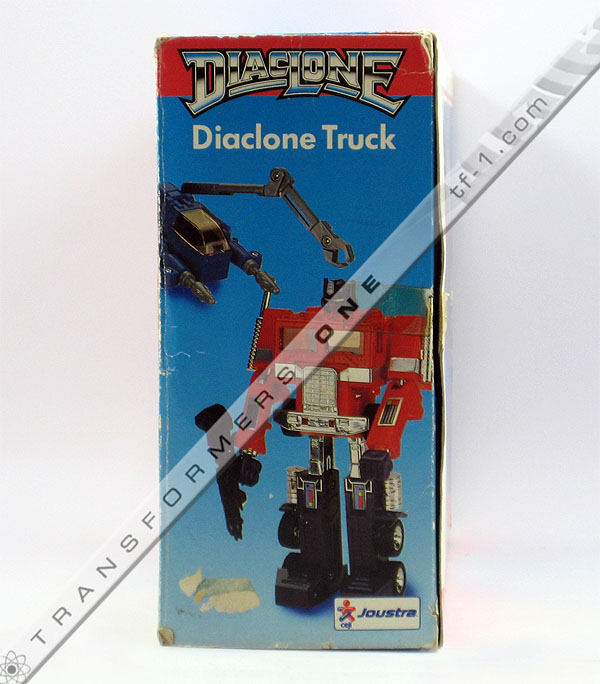
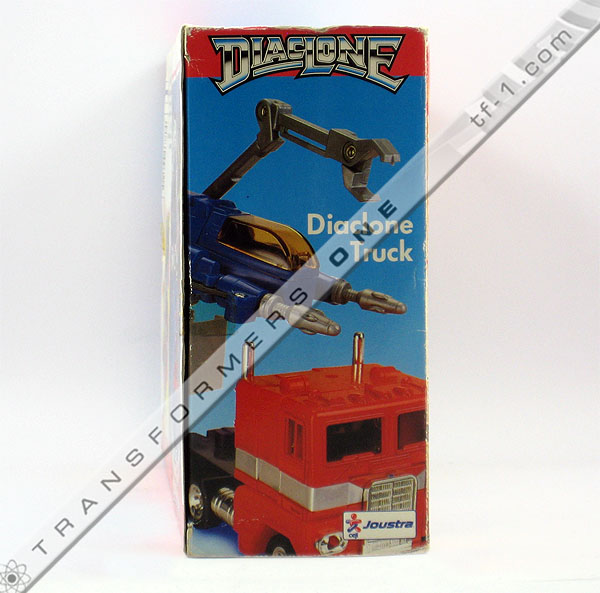
The side flaps on these Ceji Joustra Diaclones occasionally provide eyebrow-raising errors, omissions or additions, but in the case of the Diaclone Truck, all is as you would expect; the Japanese toy in either mode with the command centre cockpit visible on both flaps, "Diaclone Truck" in white, a gradiented blue background, red identifier stripe, Ceji Joustra and "Diaclone" logos. The only point of note seems to be misapplied stickersheet labels intended for the robot's feet ending up on the robot forearms, an error which is evident on the box back stock photography as well.
Let us now place the Ceji Joustra Diaclone toy in a rough timeline, starting with the Japanese Takara Diaclone Car Robot No.17 Battle Convoy from August 1983:
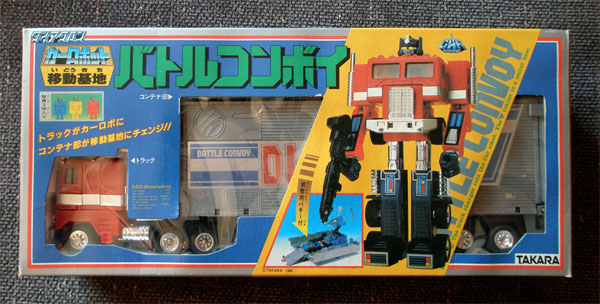

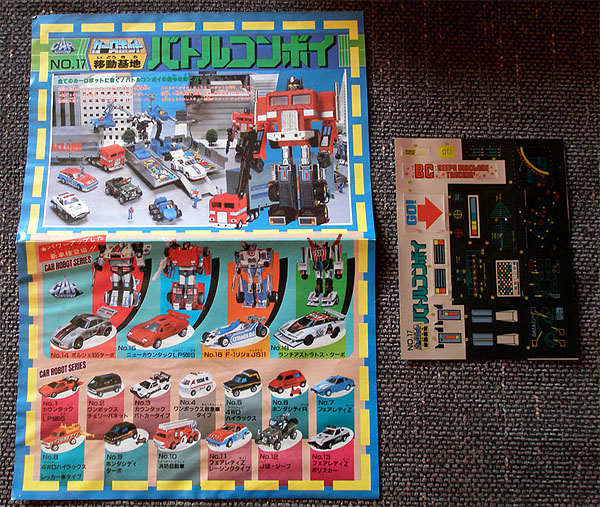
Officially the first edition of this still-used mould, the Japanese Battle Convoy did not originally feature any artwork, but has a charm and specific style of its own. The trailer parts and buggy/roller are light blue, accessories are of the collector-labelled 'bloated' variety and it came with three Diaclone drivers. The styro was unique as well, noticeably smaller than that used for the Transformers Optimus Prime and Ceji Joustra Diaclone Truck. The toy obviously has "BATTLE CONVOY - DIACLONE" plastered across the trailer, and contains the metal plates on the inside of the trailer, not to mention an immensely powerful super-launcher.
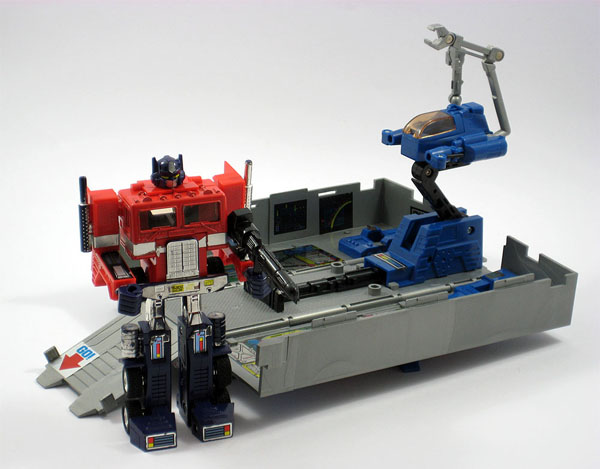
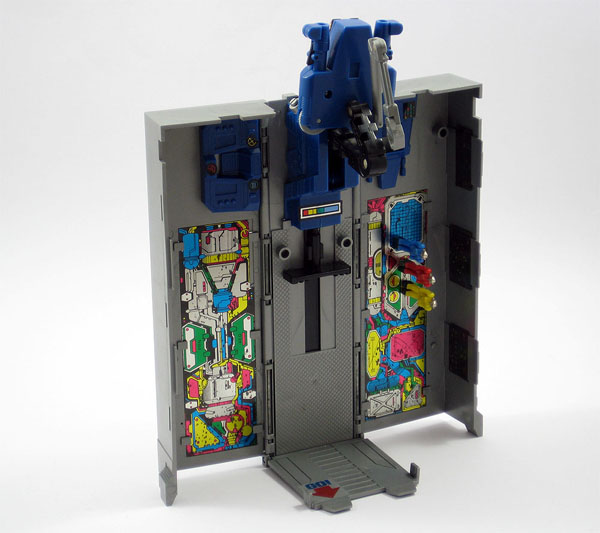
A look inside the Japanese Diaclone Battle Convoy trailer reveals the very different original launcher for the buggy/roller, a design that was only ever seen again on some Takara Transformers 01 Convoy toys released in Japan (both individually and part of the VSX giftset). As a result of the different launcher, the buggy that comes with the Japanese Battle Convoy has no pegs at the rear. We can also see the magnetic Diaclone drivers attached to one of the metal plates that line the trailer interior. It is also interesting to see where the Japanese Diaclone instructions have dictated that the "GO!" sticker should be placed, since all subsequent versions of this mould have had that sticker placed just before the trailer door. The light blue colour of the trailer parts should also be clearly evident in the above shots.
Before we move on, let's just enjoy some of the finer and "secret" details of the Japanese Diaclone Battle Convoy's packaging:
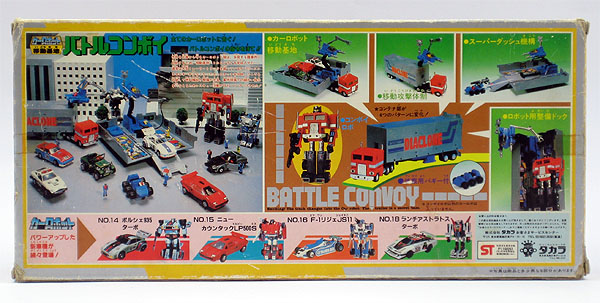
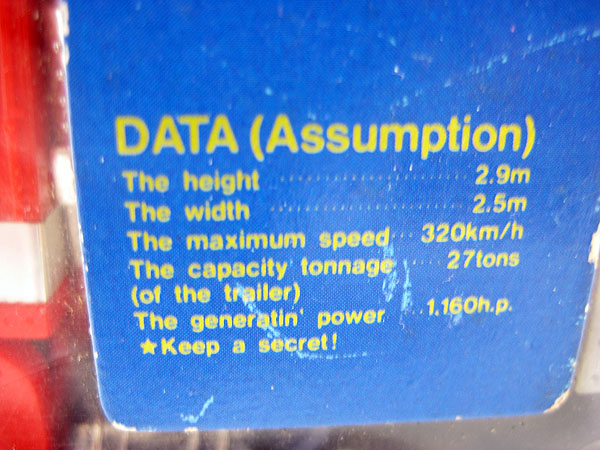
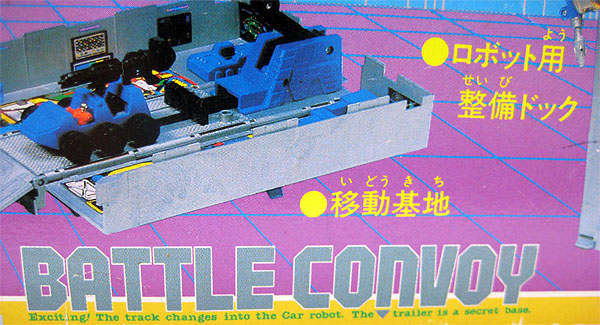
As mentioned before, the Ceji Joustra Diaclone Truck may well have been entering production at a similar time to the very first Transformers Optimus Primes. Those first Optimus Primes would have seen release in 1984, the pre-rubsign era. Since the Diaclone Battle Convoy never saw release in the same format in Italy or any other part of the world apart from Ceji Joustra's domain, those pre-rub Primes are our next historical stop.
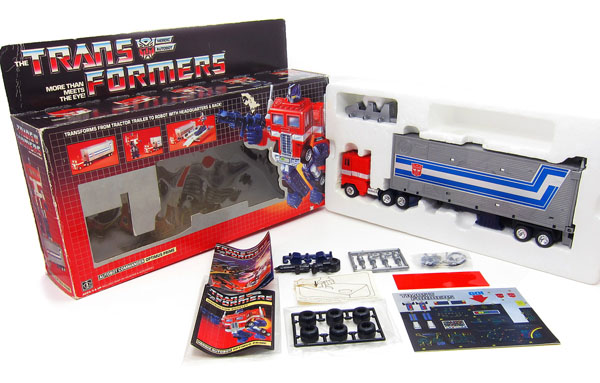
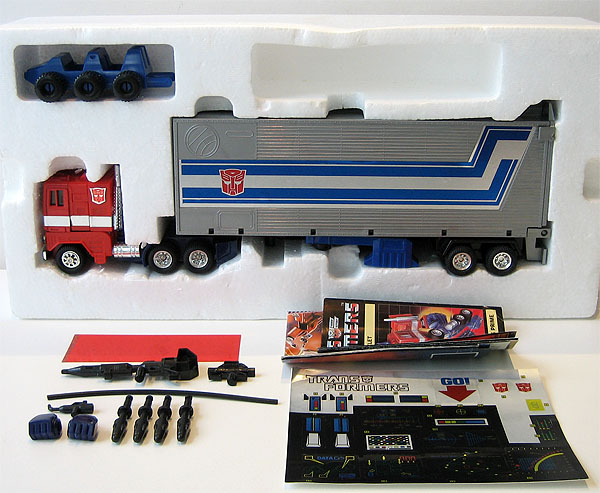
The first picture above shows the well-known and documented 'Grey-Roller Prime', which is almost exactly the same as the Joustra Diaclone Truck in moulding and colour. It even has the metal plates in the trailer, grey missiles and bloated accessories. The second photograph shows the 'Light-blue Prime' which does NOT have bloated accessories, nor does it have a grey Roller or metal plates, or even the same early mould cab. What it does have is the Japanese Diaclone Battle Convoy's very light blue Trailer and Roller parts. It is almost as if the genetic features of the Japanese Diaclone Battle Convoy were split up, creating two very different early pre-rub Optimus Primes.
Both the above toys come in the very early Hasbro "Error box" packaging, which has some interesting features of its own:

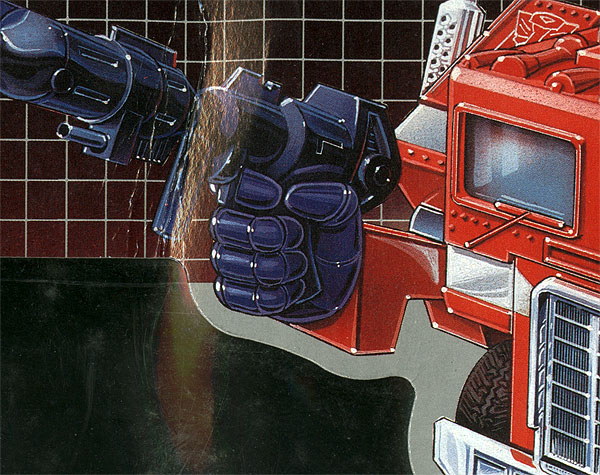
The Error box has no white borders around the three Optimus Prime stock images on the box front, and there is an extra red grid square next to Optimus Prime's fist artwork (third finger), all of which were corrected for later pre-rub and rubsign Transformers release. However, later Mexican Iga, Portuguese and Asian (non-Japanese) release Optimus Primes also had the extra grid square and were missing the white stock image borders. Going back to the early pre-rub Error box, it is thought that since no Optimus Prime box could be completely devoid of the grey-coloured cardboard sections on the box front between the cellophane window and boxart, this is as close to a "No-Grey-Border" Optimus Prime box as you can get, and is the equivalent of those super early Transformers boxes for this character. That doesn't explain the "Error" though...
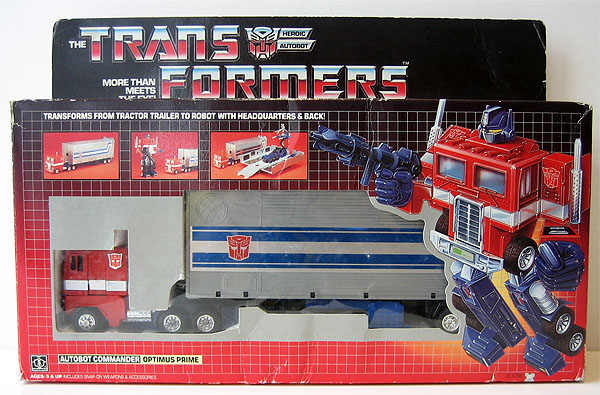
Despite the weird look afforded these Optimus Primes by the missing white borders and light blue trailer parts (or metal plates for the Grey Roller version) visible through the window, if you look just below the artwork for Prime's left foot, you can see what appears to be a small grey cross. Here are some close-ups:
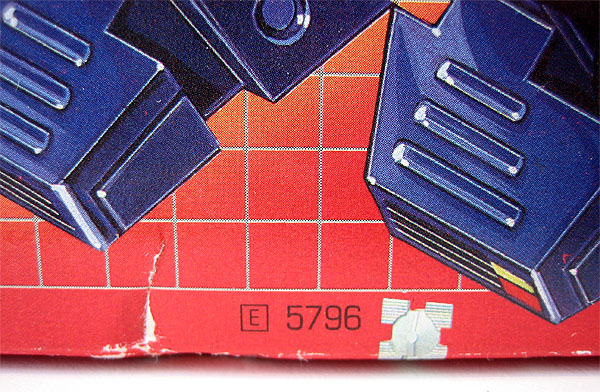
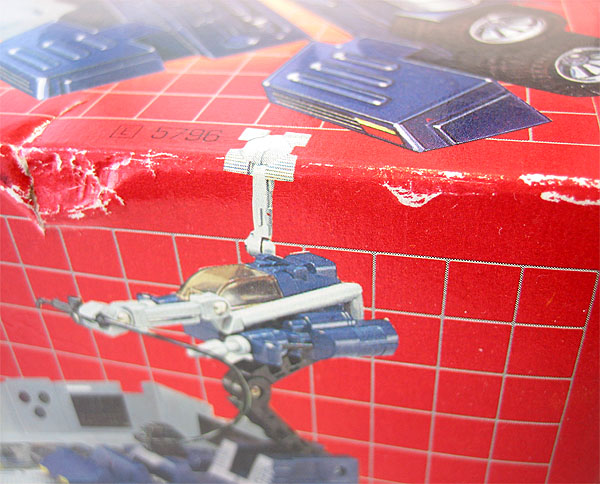
What's happened here? Someone has forgotten to crop the image of the Command Centre radar from the bottom of the box, and as a result it has encroached upon the box front! A great way to spot very early (and authentic) Optimus Prime packaging. Now it should be noted that while all 'Light blue' parts Optimus Primes have been found in this Error box packaging, 'Grey Roller Primes' come in both the Error and corrected packaging, possibly implying that it was available for longer or that the factory pumping out Grey Roller Primes had their packaging templates corrected sooner. Or maybe there were just more factories making Grey Roller Primes than those with the light blue parts, and their relative availability would support either theory.
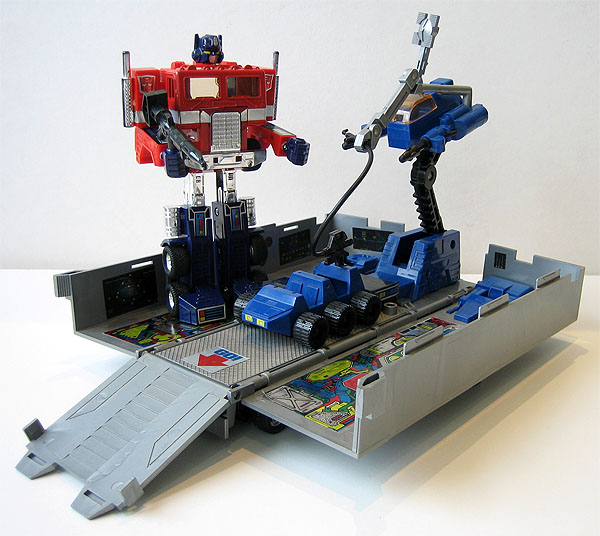
Chronologically, that brings us nicely back to the Ceji Joustra Diaclone Truck, and that art:
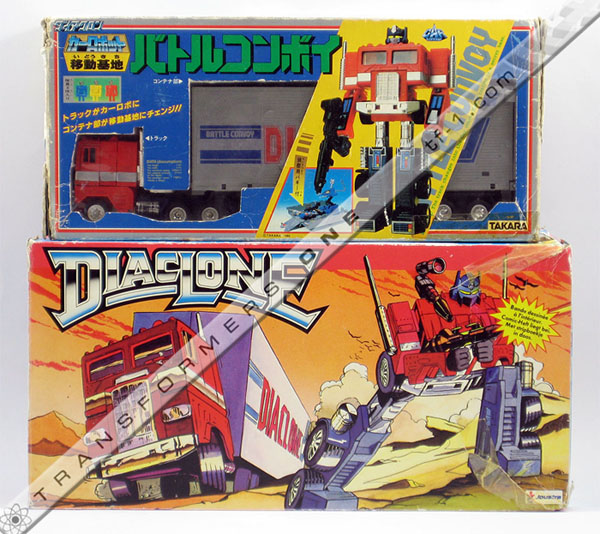
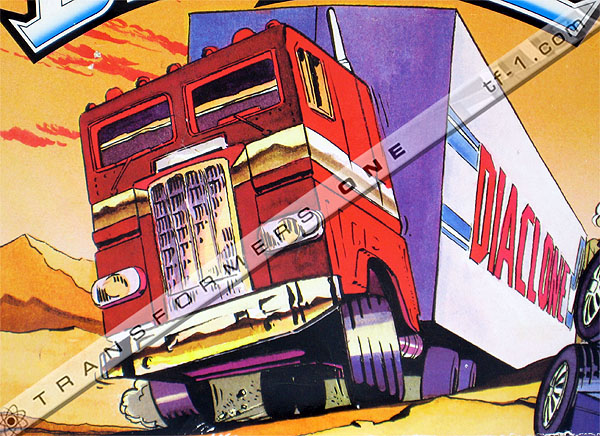
Much like the Ceji Joustra Diaclone Wave 2 artwork where well-known moulds were illustrated in their vehicle mode as well as their robot mode for the box artwork, Diaclone Truck features the only packaging artwork ever officially created for this mould as a vehicle. Paul & Gaetan Brizzi's interpretation of the Battle Convoy for Ceji Joustra's Diaclone Truck is in all likelihood the most widely recognised, adored and desired artwork for any Ceji Joustra Diaclone toy, if not any pre-Transformers toy. The sublime detail and use of colour on the cab bring this box front to life.
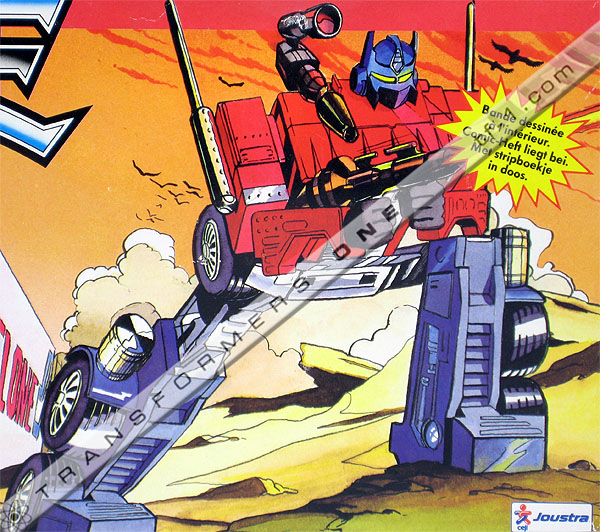
That level of detail is not at all spared when it comes to the robot mode art on the same box front, with Diaclone Truck holding a very dynamic pose, mid-combat as with almost all Ceji Joustra Diaclone character box artwork. The moulding details seen on the toy's inner legs, shins, shoulders, arms and smokestacks have all been faithfully reproduced by the Brizzis. The yellow bubble advertising the famous Joustra mini-comics is ever-present and the silhouetted birds in the background give a gloriously atmospheric feel to the whole package. Simply mighty.
The pre-Transformers educated amongst you will also notice that Diaclone Truck has a shoulder weapon attachment that was never released with the production toy in Japan or elsewhere, but was shown with Battle Convoy prototypes in Japanese Diaclone literature. Ceji Joustra Diaclone Truck is also drawn holding a Trainrobo (pre-Raiden) hand gun. The source?
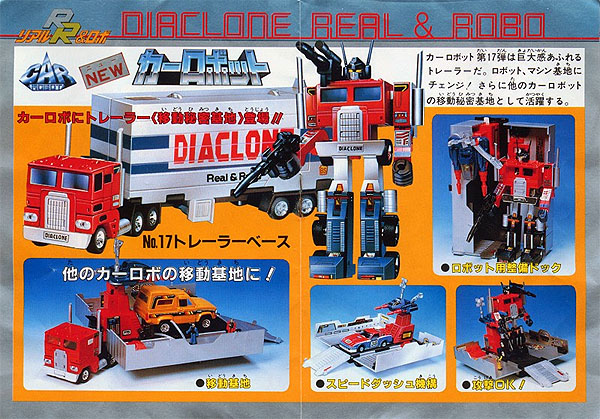
Take your pick of where to look on that catalogue scan for pre-production Japanese Battle Convoy oddities and fascinating prototype features; the red Hilux-mould missiles for the Command Centre, the long robot antennae and of course the Trainrobo gun and shoulder cannon which strangely are the only features to appear on the Ceji Joustra Diaclone Truck artwork. It is possible that the Brizzis had access to this Japanese Diaclone paperwork and just made an artistic choice for the illustrations.
Originally the Ceji Joustra "Diaclone Truck" was not even meant to have that name, it was referred to in very early Ceji catalogue literature as "Camion Mack", specifically on the aforementioned early 1984 order sheets that would have been distributed to dealers and retailers. You can see it below next to his assortment number of 9611:


With our packaging analysis and historical build-up complete, we can take our first look at the production version of the Ceji Joustra Diaclone Truck:
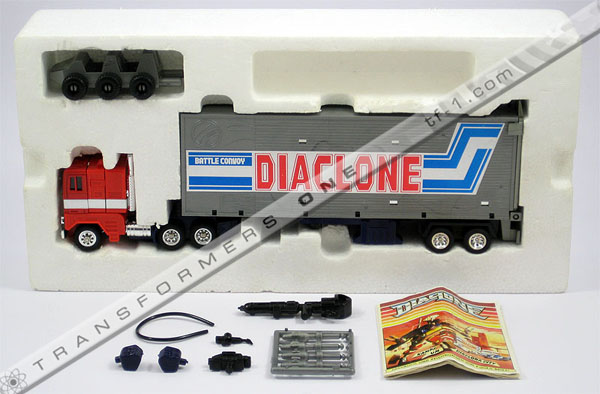
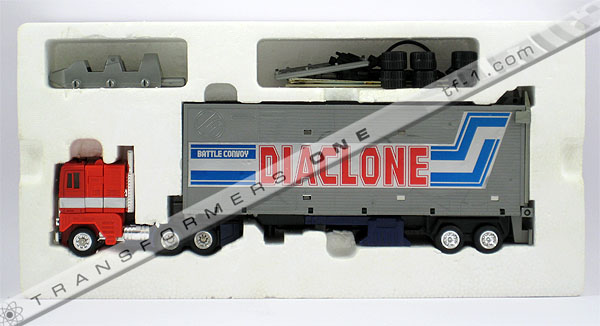
Gazing upon Diaclone Truck's contents, we see that the styrofoam insert tray is the same as that used for the Transformers Optimus Prime and not at all similar to the smaller Japanese Diaclone Battle Convoy insert. The buggy/roller is grey with pegs, the missiles are grey, accessories are of the bloated variety, the toy has "BATTLE CONVOY - DIACLONE" emblazoned across the trailer and the small rectangular cut-outs on the trailer sides reveal the metal plates inside. The first release Diaclone Trucks had a Joustra mini-comic included (as did all early Wave 1 boxed Ceji Joustra Diaclones) and it should be Chapter 9, but later the mini-comic allocation was slightly more random, then finally its inclusion was halted altogether possibly due to licensing issues.
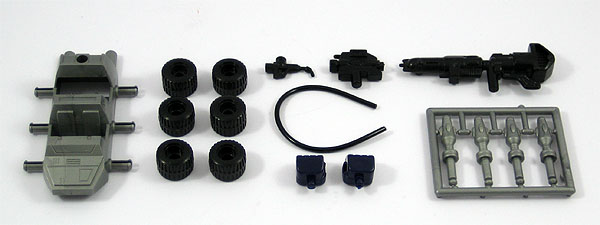
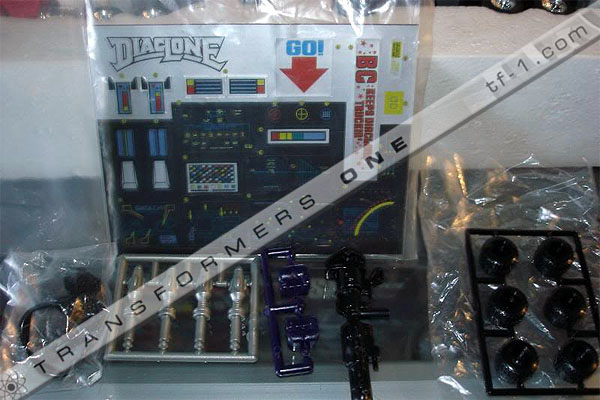
This last image above of a more unused Diaclone Truck specimen's contents shows how the buggy wheels and fists were originally sprued, and how the stickersheet is almost identical to the Japanese Diaclone's label sheet with the exception of the stylised Brizzi-inspired "DIACLONE" logo in the top-left corner in place of the Japanese Diaclone logos. Here's a closer look:
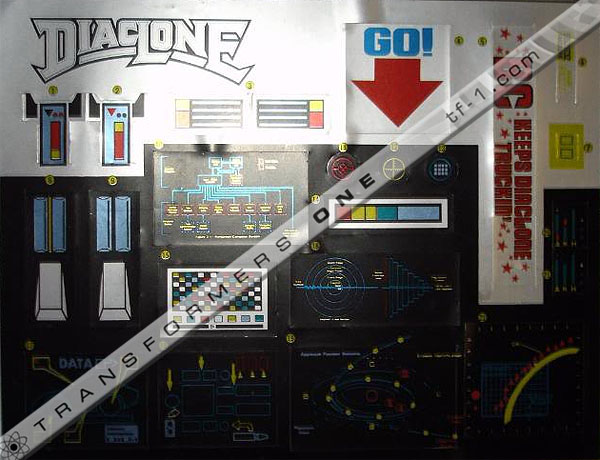
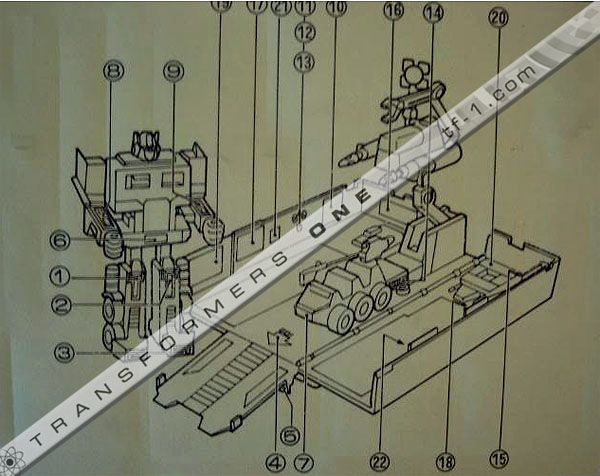
Plenty to take note of here, the front of the stickersheet contains the brilliant Battle Convoy "BC Keeps Diaclone Truckin'" label for the rear bumper of the trailer (Sticker #5), as well as the "55263Z DIACLONE - HIGHWAY B4377" cab licence plate decal (Sticker #6). As alluded to previously, the "GO!" sticker (#4) is positioned before the trailer door exit as it is for Transformers Optimus Prime, but unlike the Japanese Battle Convoy where it's actually positioned on the trailer door interior to one side. The hybrid nature of this Ceji Joustra Diaclone toy and release is evident throughout its construction and presentation, and we'll come across it a few more times before the end. There are no instructions included of course, as with all Ceji Joustra Diaclones the sticker map on the rear of the stickersheet is about all the guidance you receive with these toys.

The "Duel Sur Diaclona / Kampf Um Diaclona City" (War On Diaclona) mini-comic story features Diaclone Truck very heavily as you would expect, but instead of showing all of Chapter 9 again, let's instead look at just a few of the different panels in which "Diaclone" appears in the chapters that have been found to date. In Chapter 9 we see him quite often as he co-ordinates an attack with "Toyota" (pre-Trailbreaker), and his truck mode box artwork is clearly sourced from the last panel of following page:

Here he is again with Toyota in the last panel from preceding Chapter 8, awaiting "Condor's" (Pre-Laserbeak) return after the cassette successfully despatches "Robocolt" (pre-Browning) and delivers sensitive data about the enemy's movements:

"Diaclone" also appears prominently in Chapter 10, seemingly the final part of the Wave 1 story where the evil despot "Multiforce14" (GATS Blocker) is defeated. Here we see him blasting "Microrider" (actually a Ceji Revell "Diaclone" model kit release) mercilessly through the chest not unlike how Optimus Prime gunned down groups of Decepticon lackeys in Transformers The Movie:
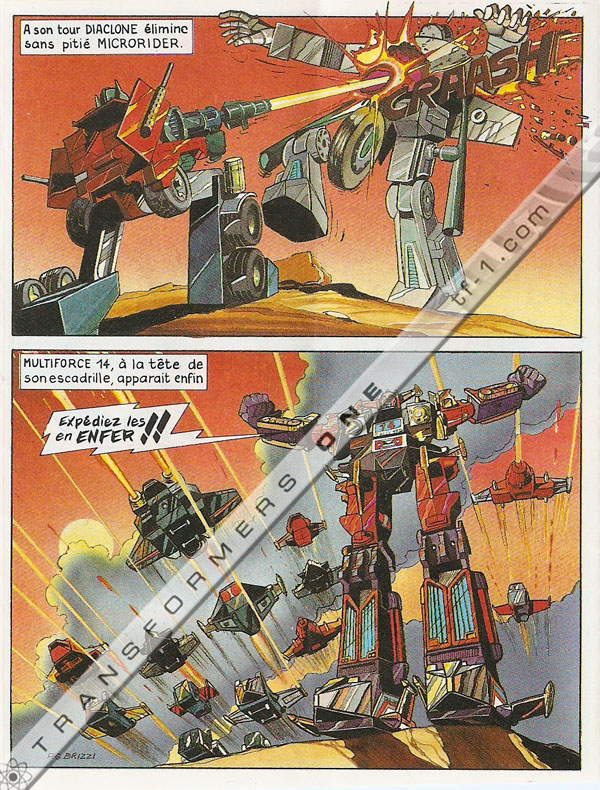
Beautifully drawn and coloured I am sure you will agree. If you look really closely at the last panel below, in the bottom left corner, you can see "Diaclone" in what appears to be a much smaller and lower-detail version of his boxart pose in robot mode.

Going in closer...
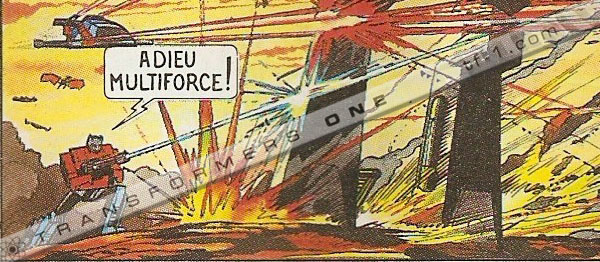
No shoulder cannon this time. Since he does not appear in any other comic that has been found (although he is assumed to have played a big role in the possibly-unreleased Chapters 2 & 3), it is unlikely that he would have struck that precise pose again elsewhere, leading me to conclude that the illustration on Diaclone Truck's box front was specifically drawn for the packaging and not the mini-comic, as most other illustrations used on Ceji Joustra Diaclone packaging were. Either that, or there are unused comic panels where he is shown in the box front pose with higher detail in alternate versions of the chapter(s).
So that's the paperwork covered too, leaving only the main event.
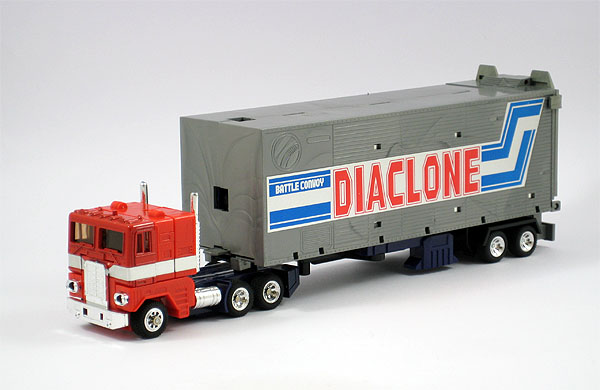
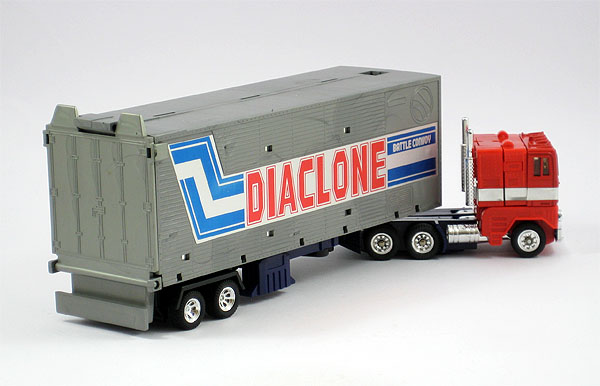
Is there any other word but 'beautiful' to describe the Diaclone Truck's appearance? Ample chrome and shiny factory labels, tinted windows, painted die cast and moulded coloured plastic in a perfect ratio. Every single inch of this vehicle's proportions are spot on and it has an undeniable majesty about it. There's just something so awesome about being able to see the glint of the metal plates through the small rectangular cut-outs on the trailer. The massive "DIACLONE" text on the side does not even approach overkill levels, and no matter how much I try to separate this Diaclone item from Transformers Optimus Prime, my childhood exposure to The Transformers and this toy will always colour my perception of "Diaclone Truck", and not in any negative way either.
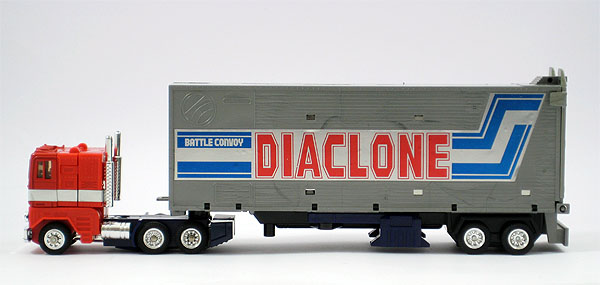
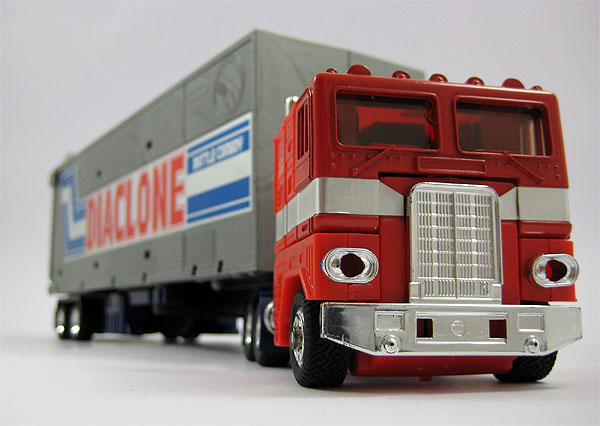
Often, the Ceji Joustra Diaclone toys that have Transformers counterparts can be indistingusihable from pre-rub Transformers when loose and in unused condition, so there's not an awful lot to set them apart. In the case of the Diaclone Truck though, the unmistakeable trailer decoration adds even more special appeal and character to this particular release. In fact, this release is completely unique in that the combination of the grey buggy and missiles, bloated parts, metal plates, dark blue trailer parts and "BATTLE CONVOY - DIACLONE" lettering are not seen together on any other release of the Battle Convoy or Optimus Prime mould. It seems to sit perfectly between the Japanese Diaclone toy and the US 'Grey Roller' pre-rub Transformers toy. Being the only version of Battle Convoy ever sold outside of Japan, it's not just special, it's important too.

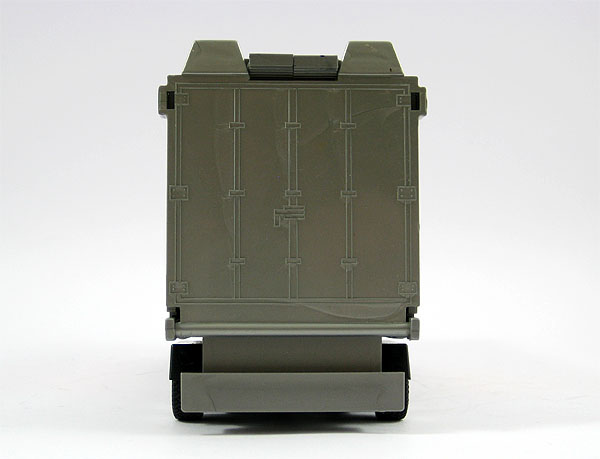
The toy has a very real feeling of quality to it, despite being an unused specimen for the most part, it had a confidence-inspiring sturdiness to it and even opening up the trailer was not sweat-inducing. Nearly everywhere it was tight but not to the point where excess force would result in 30-year old shattered plastic soaked in tears. Having said that, the left chrome headlight/wrist was quite loose (probably out the factory) and was prone to rotating. I have always believed that the original Japanese Diaclone toys were of lesser quality than those manufactured for The Transformers, and this item would have been right on the cusp of that period of higher quality production.
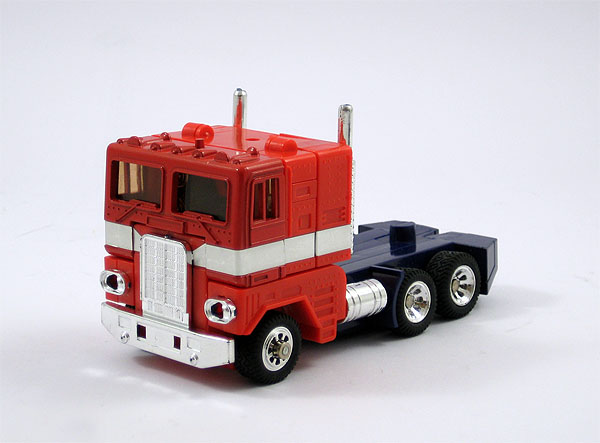
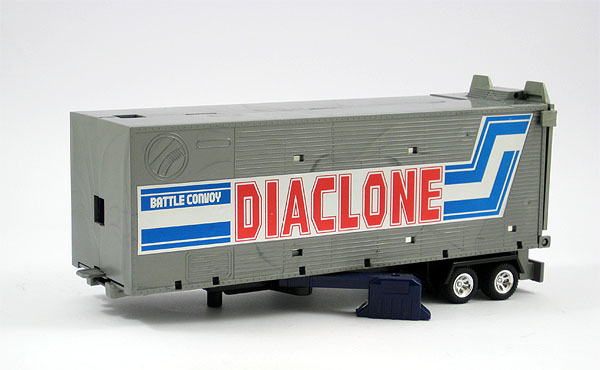
The painted red die cast section of the cab is noticeably darker than that of the moulded red plastic. There appears to be less of a difference between the red sections of the cab on the Transformers early pre-rub Optimus Primes, but a similar difference seemed to be evident on the Japanese Diaclone Battle Convoy cab. I found that the legs on the trailer were probably the tightest part of the whole package, not really wanting to open out much more than shown in the photograph above. A very quick way to tell the Ceji Joustra Diaclone and Japanese Diaclone trailers apart without looking inside is to examine the colour of the plastic legs on the trailer; dark blue is Ceji Joustra and light blue is Japanese. Notice also how much swirling there is in the grey plastic of the trailer.
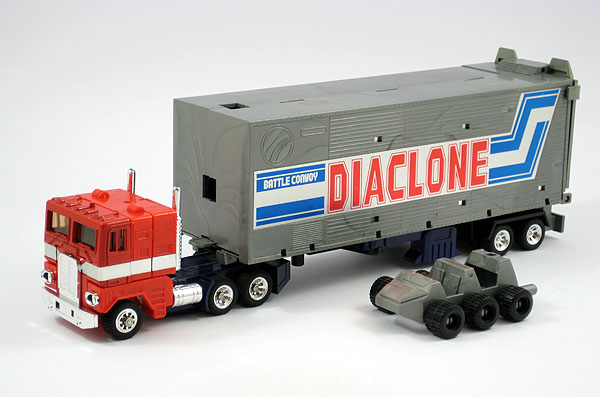
One of the qualities of the Convoy toys that has made them successful, be it Battle Convoy, Powered Convoy or even Optimus Prime, is the inclusion of so many accessories and peripherals. While the original Japanese Diaclone Battle Convoy would have had three Diaclone pilots/drivers, all subsequent versions had to make do without, but they still boast the buggy (or "Roller"), gas pump, nozzle and hose, command centre cockpit with 4 firing missiles and buggy launcher and even a respectable base mode.
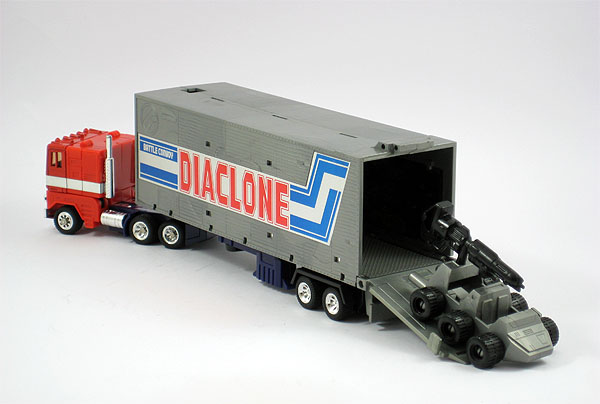
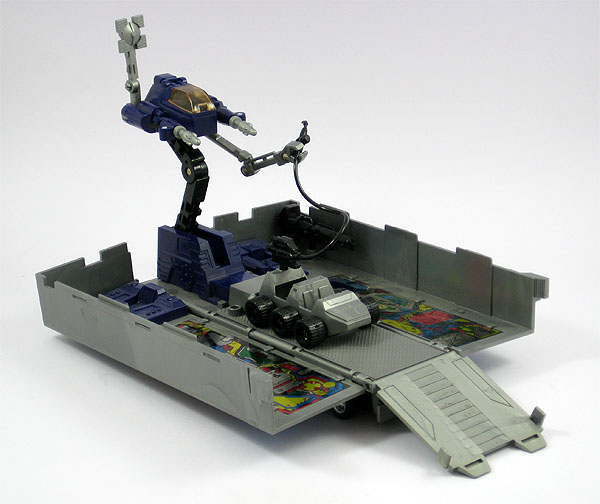
The base mode features a cockpit for the Diaclone drivers, a modified weaker launcher compared to the Japanese version (which could basically put Roller through a wall) and of course those metal plates for the no-longer-present pilots. The launching tab often appears to be non-functional on Ceji Joustra Diaclone Truck trailers, but it's usually a case of attaching the buggy to the launcher via the pegs before the tab will actually activate the launcher. It is also important to note that the launcher is the same colour as the buggy/roller, all of these little details are very important to memorise when evaluating value and possible purchases.
Missile launchers are potent on the Ceji Joustra Diaclone version and mercifully the radar and robot arm were not loose so they could be posed holding the nozzle. The main Diaclone Truck handgun can also be stored in the corner of the trailer as it can with Optimus Prime.

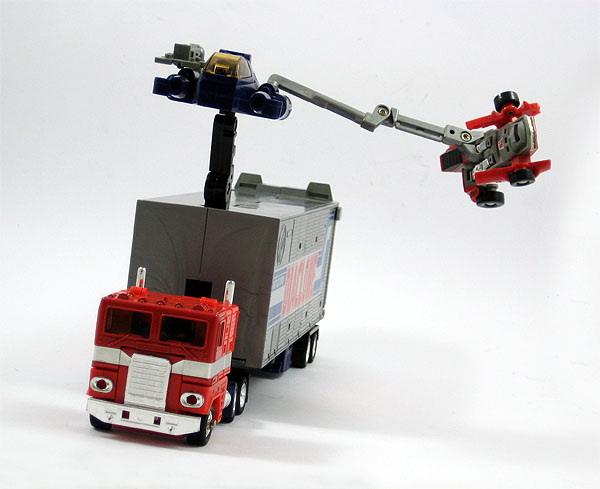
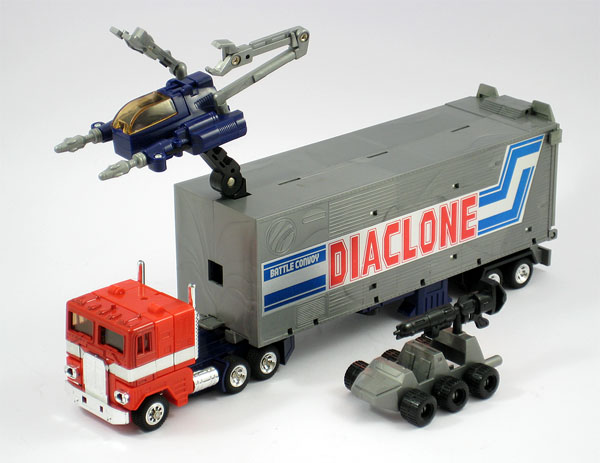
The cockpit from the trailer can be displayed poking out the top of the closed trailer as a sort of vehicle attack mode, and the hand gun can be attached to the buggy/roller. While these other features and modes can be great fun to explore, it's hard to imagine this toy being displayed in any mode besides the truck or robot mode. Or in its packaging!
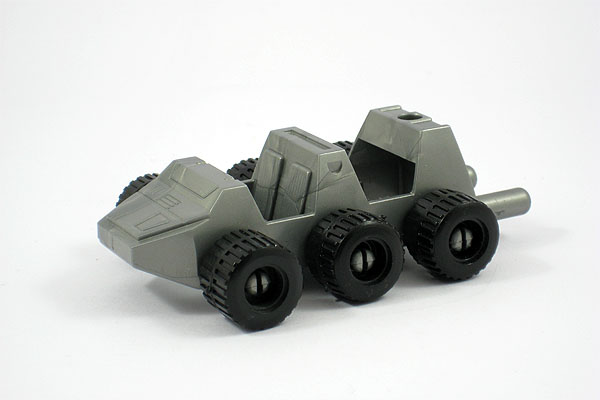
The grey buggy/roller is a wonderful addition to this Ceji Joustra Diaclone set, as it's probably the least available vintage version of the mould along with the light blue Optimus Prime Roller, but this is more interesting. The wheels for the vehicle come sprued and can easily be popped on or off. The plastic appears to have a sparkly look to it, and I have been told that the Japanese and Ceji Joustra Diaclone Battle Convoys have sparkly bits in the grey plastic of the trailer halves and even the command centre robot arms, whereas the Transformers Optimus Primes apparently do not have those sparkles.
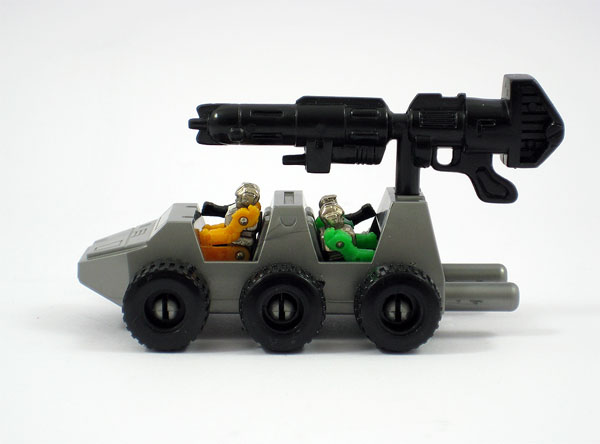
Grabbing a few Japanese Diaclone drivers and putting them in the buggy/roller truly brings out its original purpose as a mini armed transporter. What I hadn't realised before was that the second row of seats in the buggy seat the drivers facing backwards. It is quite a shame that the driver concept was not carried over to the Ceji Joustra Diaclone toy line, especially now that their value on the second-hand market has risen significantly even compared to 5 years ago. Their omission also brings an element of redundancy to the metal plates in the trailer.
Now for a short close-up tour of some of the standout vehicle mode features on the Ceji Joustra Diaclone Truck:
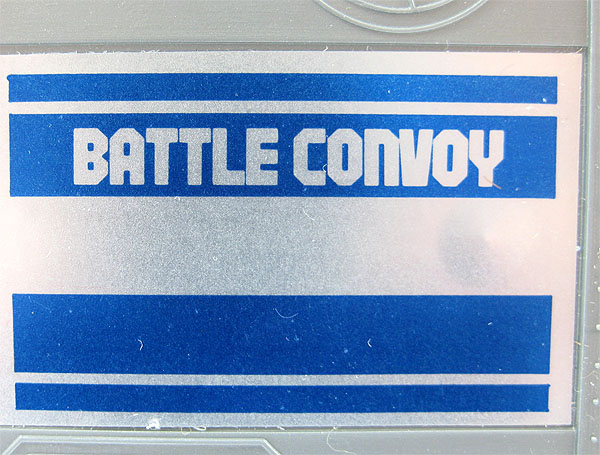
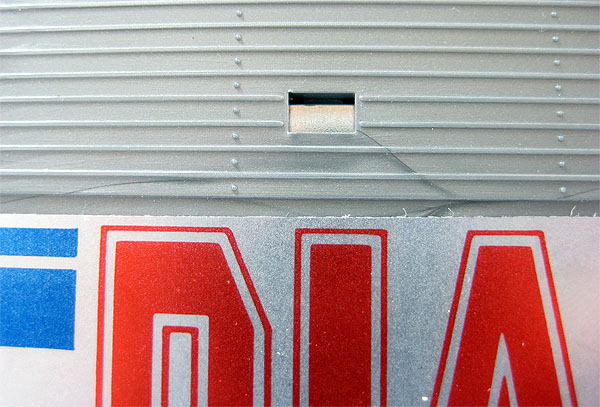
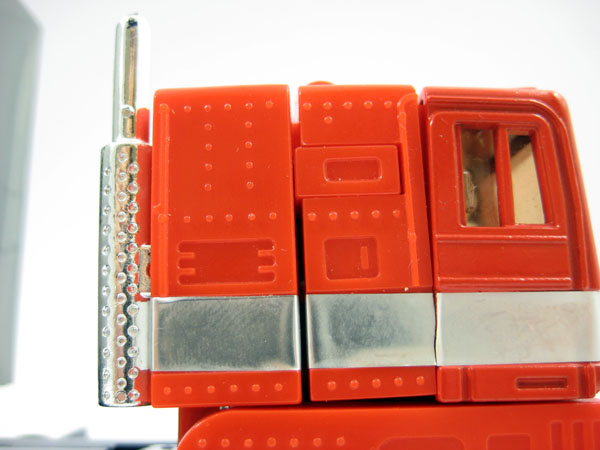
This last photograph above highlights a tell-tale section of the cab which comes in very handy when trying to identify a Diaclone or pre-rub Battle Convoy/Optimus. We can see that the chrome smokestack is connected to the red plastic through a rectangular chromed piece of plastic. This is sometimes referred to in the collecting community as a "square connector" or "square smokestacks", and is found on Japanese and Ceji Joustra Diaclone Battle Convoys as well as Grey Roller pre-rubsign Optimus Primes. Later Optimus Prime cabs have circular (or more accurately, cylindrical) connectors there. A slightly lesser-known trait of those same early cabs sits right next to the smokestack, a raised vertical red plastic bar. On later pre-rub and rubsign Optimus Prime cabs, that raised vertical plastic bar doesn't lie next to the smokestack, but on the opposite side of that shoulder, alongside the hinge that connects the shoulder to the rest of the cab. For comparison, here is a later mould cab (from the 'Light Blue Prime'):
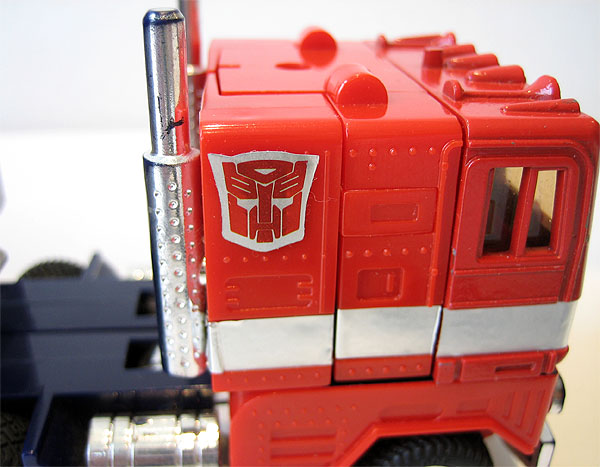
You can see the cylindrical smokestack connector and the vertical bar's changed position (on the right of the Autobot sticker).
Back to the Ceji Joustra Diaclone Truck and more vehicle mode close-ups:
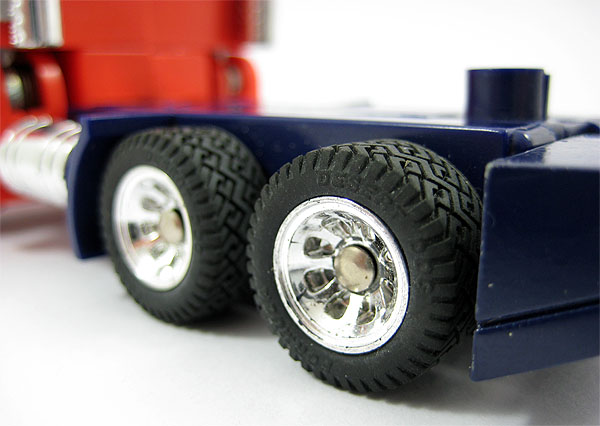
A close look at the wheels reveals the tyre markings "Formula Desert Dog", a 1970s/1980s brand of off-road tyre for trucks, jeeps and the like, manufactured by the Armstrong Tire Company. That protruding front wheel peg/axle on the Diaclone Truck cab is as recogniseable a toy feature as can be found on any iconic action figure throughout the world.
Before we move onto the robot mode, let's have a look at a stickered-up Ceji Joustra Diaclone Truck and some Battle Convoy-specific decals:
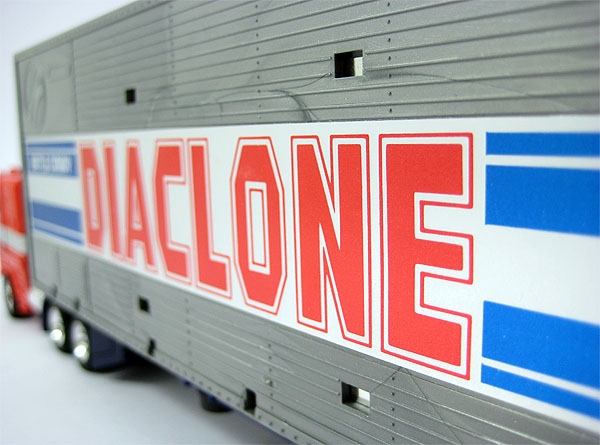

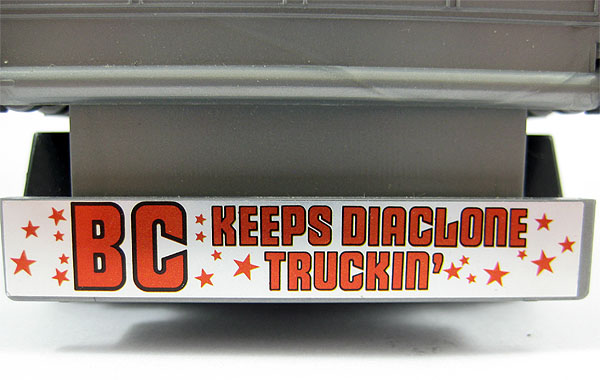
As a point of trivia, if you look at a Transformers G1 Optimus Prime box, the stock photography on the side flaps and box top show the cab with the yellow Diaclone licence plate sticker, however the "Diaclone" is manually crossed out:
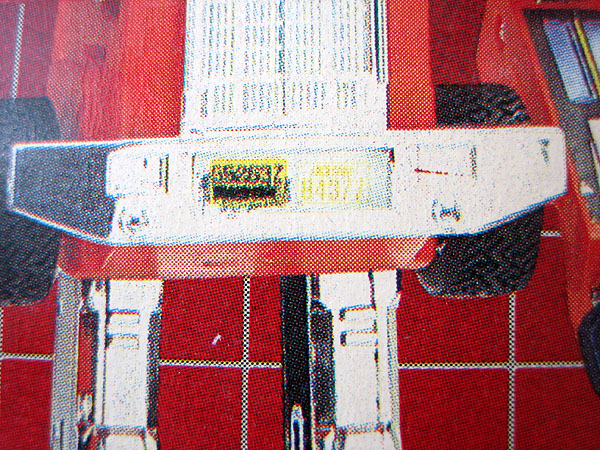
As we move on to the robot mode for the Ceji Joustra Diaclone Truck, we are once again reminded of how ingrained the image of Optimus Prime is in our psyche and our memories. I won't lie, the only reason I became interested in Diaclone and Ceji Joustra Diaclone is because I grew up with Transformers and Autobot cars, that was my way in. With that in mind, and considering all the typical words I've already used like "iconic" "famous" and "talismanic", the only word left to describe this toy's robot mode is...
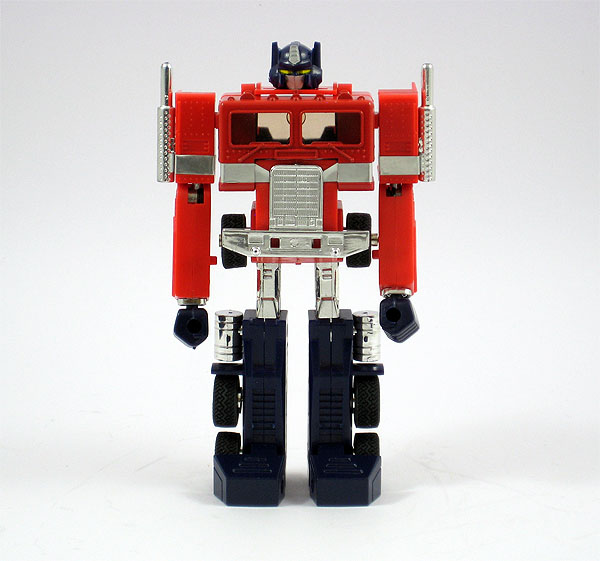
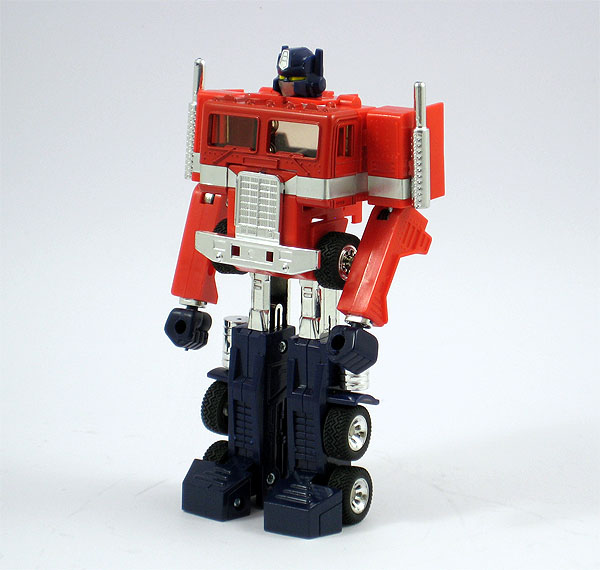
...evocative. If you are a Transformers collector it may evoke memories of that Christmas where someone bought you a G1 Optimus Prime, or in my case seeing my best friend's Optimus Prime for the first time. I had to be different and ask for an Ultra Magnus! If you are a Diaclone collector it will evoke feelings of awe at how Takara could come up with such a concept that would be revered for decades to come even when technology had far surpassed its original design. If you are a neutral it may evoke nostalgic feelings from your youth and remind you of being young, and if you are a child then it will evoke feelings of curiosity at just how such an ancient toy could have so distinctive yet simple a face, gorgeous bodily proportions and such a striking contrast of red, chrome and blue. You would be moved to know who this robot was, and you may even know the name "Optimus Prime" from a past Summer's blockbuster movie, without realising this is the toy responsible for all of that. For now, he is the Diaclone Truck in robot mode, looking decidedly docile without his weapon.
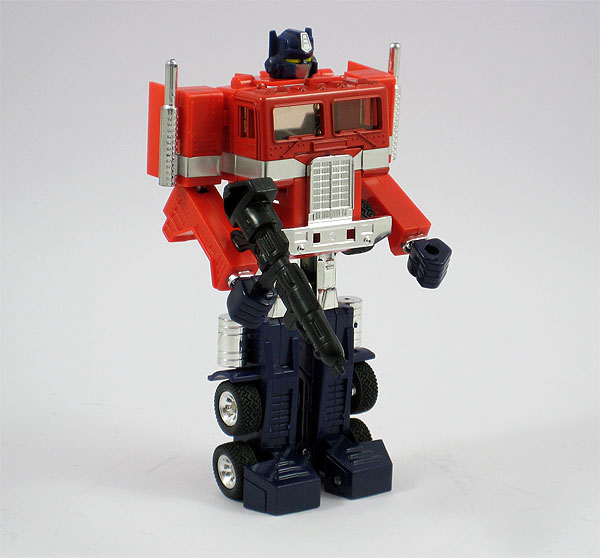
The handgun for this figure is almost as recogniseable as the robot itself, and you can really see why collectors use the term "bloated" for this set of accessories. The gun is almost comically fat, but at least it has presence. Due to the gun's proportions, it is very hard for the robot to hold it facing forwards and still have it sit flush in his fist, explaining why a lot of stock photography shows the robot holding the gun angled out or pointing inwards.
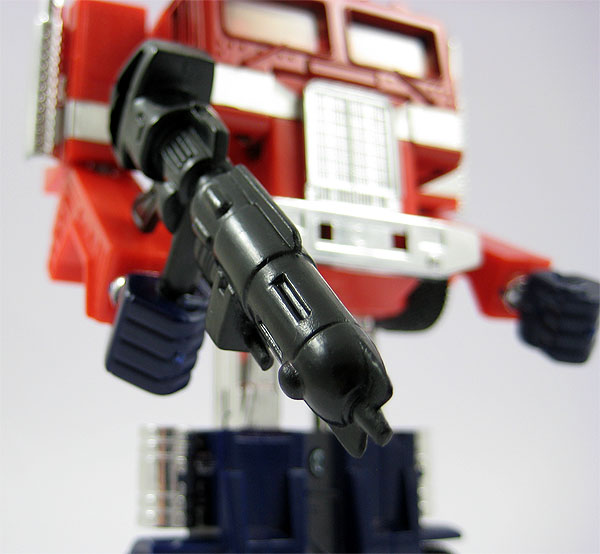
You wouldn't want that pointed at you now, would you? Compare with the non-bloated accessories included with the early pre-rub 'Light Blue Prime' accessories from the same year:
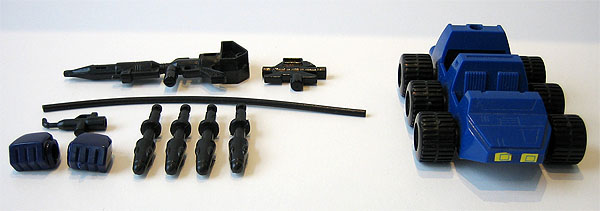
As with its vehicle mode, the Diaclone Truck can be displayed successfully alongside its base in robot mode and can even interact with it:
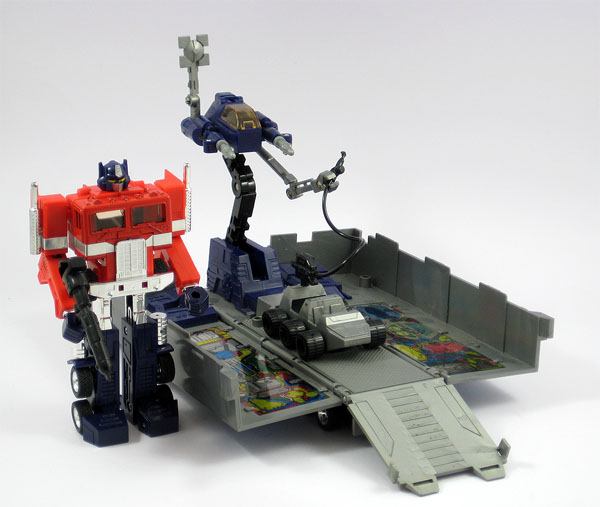
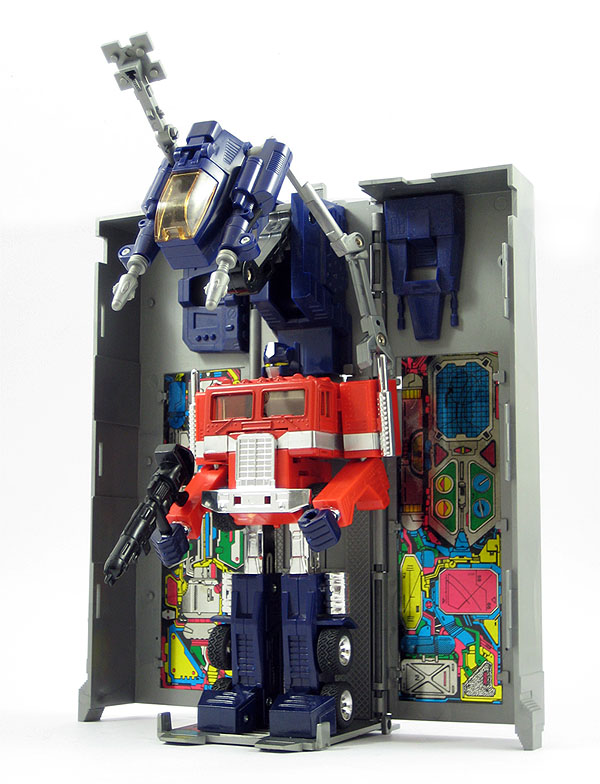
It is so enjoyable to set the Diaclone Truck up with its base acting as a repair unit, far moreso than with the Diaclone Powered Convoy. This mode looks intentional instead of incidental, and if the command centre joints are still tight, it makes for a spectacular display arrangement.
Speaking of those tight joints, as nice as the Diaclone Truck in this article is, this is a toy that struggles to hide damage, chrome wear and age. The smoke stacks, leg chrome and grill sections suffer heavily from wear, the silver cab stickers can peel in the blink of an eye, the paint on the robot head can wear without great provocation also...and that's to say nothing about broken trailer door hinges and command centre joint looseness. Having so many accessories makes it hard to find and complete these toys to the required standard.
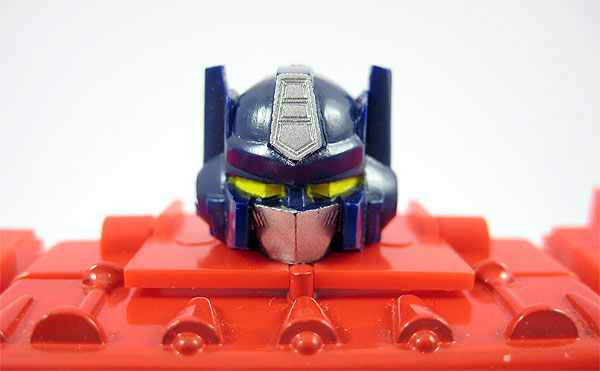
With so much paint apps on the robot head as opposed to moulded plastic parts, even the slightest wear can affect displayability. The silver paint on the mouthpiece and head grill are notoriously susceptible. Negativity aside, it's a simple and effective headsculpt, very robotic...and very hard to judge from my perspective how I would feel about its level of character if I had not grown up with Optimus Prime.
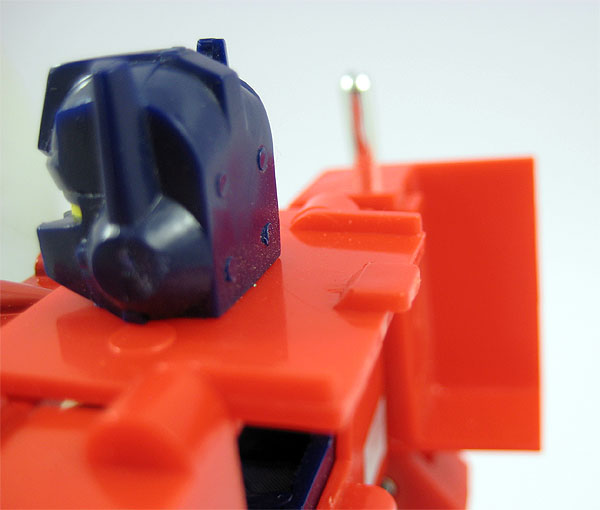
Remaining on the topic of the Ceji Joustra Diaclone Truck robot head, we've already discussed how to tell an early Diaclone-style and early pre-rub cab apart from late pre-rub and rubsign era Optimus Prime cabs, and we know how to distinguish between the Japanese and Joustra Diaclone trailers, but how do you tell the Joustra Diaclone cab apart from a Japanese Diaclone cab? The tells are behind the Diaclone Truck's head.
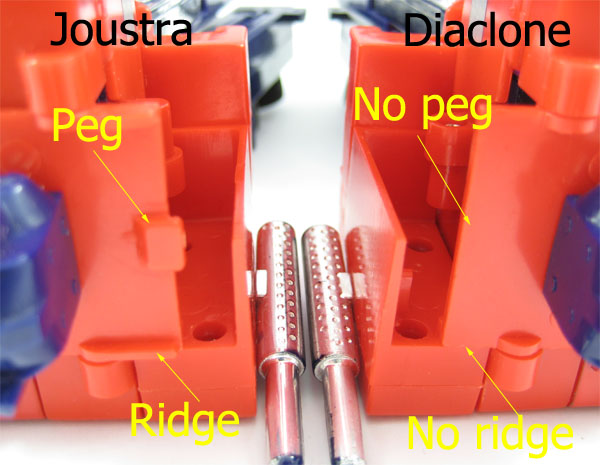
The above picture illustrates nicely what to look for, a peg and ridges on the Ceji Joustra Diaclone Truck headplate that are not present on the Japanese Diaclone Battle Convoy headplate. Incidentally, I found the Japanese Diaclone headplate immensely hard to rotate, it's no wonder they updated the moulding around that section for the immediately subsequent releases of the mould.
The differences don't end there...
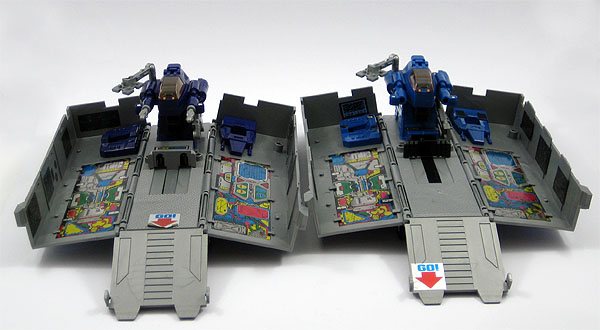
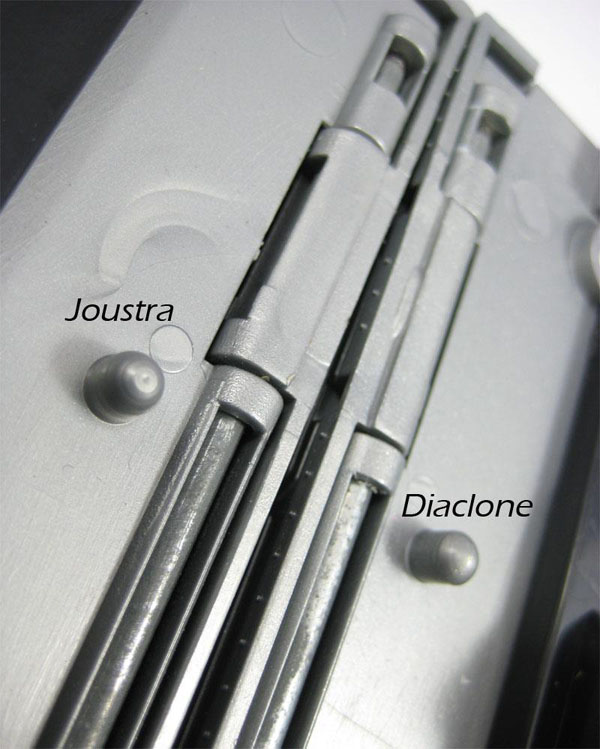
In addition to the obvious colour and moulding differences seen on the trailer interiors, there is a small moulding change on the underside of the trailers relating specifically to the pegs responsible for holding the trailer legs in place. The Ceji Joustra appears to have a more bevelled end on the peg. This is just pedantic detail though as there is so much else to distinguish the trailers, but it always helps to be aware of every little thing that an unscrupulous seller could swap.
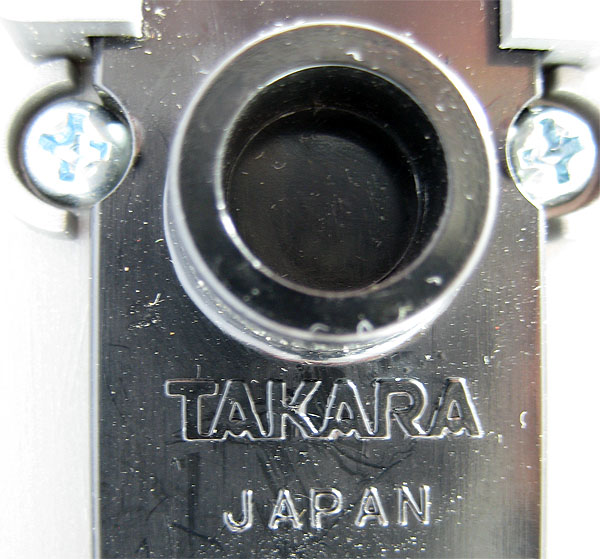
Not surprisingly, the Ceji Joustra Diaclone Truck shares the same copyright stamping as that seen on the Japanese Diaclone Battle Convoy, a simple "TAKARA JAPAN" without dates, without Kanji, without mould numbers or anything else. The lynchpin hole is also devoid of any "T" markings. There also exists a later-release Ceji Joustra Diaclone Truck with the same moulding features as this one, but the copyright says "TAKARA CO LTD - JAPAN 1980 1982", so the Diaclone Truck has the same two copyright variations as the 4 Car Robots (Toyota 4x4, Ambulance, Porsche 935 Turbo & Ligier). That later stamping variant still has a grey buggy/roller, grey missiles, bloated parts and metal plates.
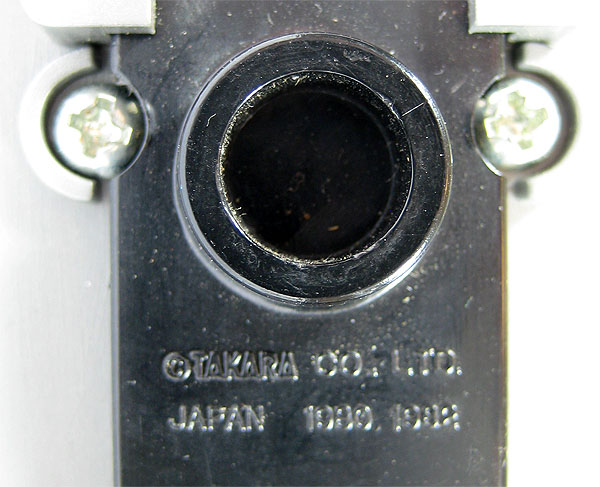
The only real difference I found between the two trailers was in the plastic mould swirls in the grey plastic, the most noticeable one being a rather insignificant extra swirl in the first mould trailer top:
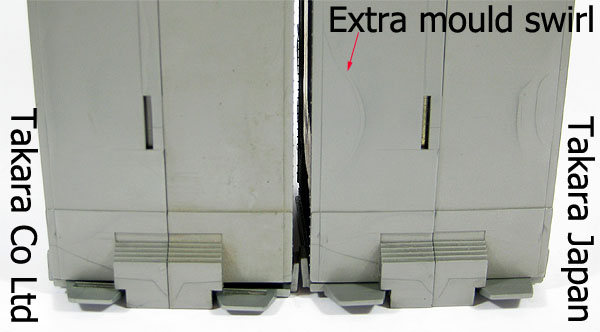
When it comes to a toy as widely manufactured as Optimus Prime, and the multitude of accessories and parts that can come off or get lost, there are a few things that you must look out for when buying what is advertised as a Ceji Joustra Diaclone Truck or even a Battle Convoy. First of all, buggy/Roller wheels, the following picture shows the difference in moulding on the inner part of the wheels, and I only bring this up because I found a few questionable features on my Diaclone Truck that led me to believe it had experienced parts-swapping in its past:
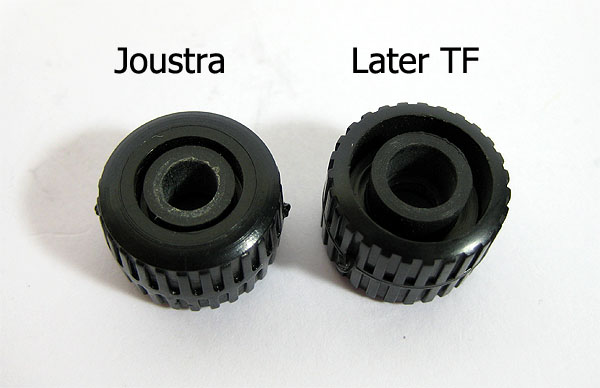
A lot of these toys can be found with broken trailer door hinges, and if the hinge breaks, the door comes off really easily. This can result in lost Ceji Joustra Diaclone Truck doors, sometimes replaced with much more common and easily accessible Transformers Optimus Prime trailer doors. The following image shows what to look out for as just one example of a parts swap, the trailer door on the left is from a Ceji Joustra Diaclone Truck (both stamping variants), the one on the right is from a rubsign-era Transformer:
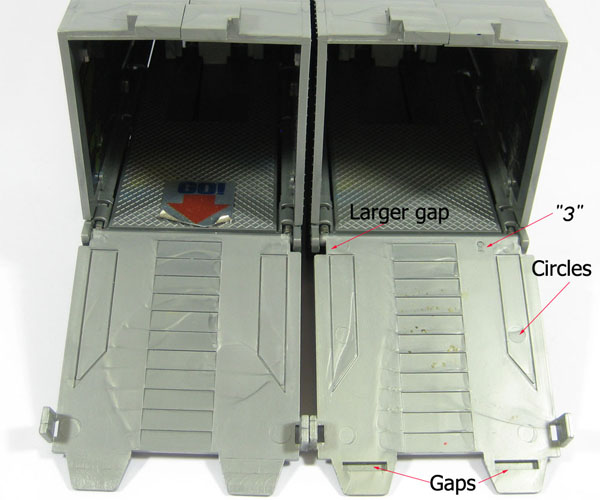
What you may realise now, then, is looking back at the photography in this article of the "unused" Ceji Joustra Diaclone Truck, at some point in its history it has had a Transformers Optimus Prime trailer door fitted as a replacement for its original trailer door. A shame, as it compromises the integrity and authenticity of much of the article photography. But, as long as we know the truth, then the point comes across. Then again, you never know, since starting this article the number of Ceji Joustra Diaclone Trucks I have seen with the "3" stamped door compared to the plain door is 3 to 12, never say never in this game.
Since we've approached this article from a chronological point of view, we can now look a little at some of the subsequently released versions of the mould that are loosely related to what we have discussed so far. Just before we stray too far from 1984/1985, let's have a look at the Hasbro Transformers Optimus Prime instructions:
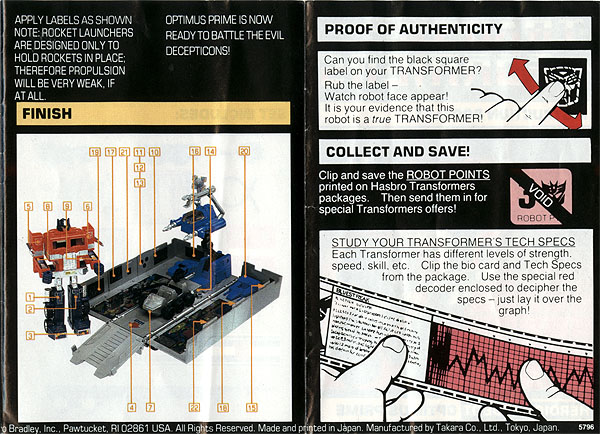
This rubsign-era instruction booklet is close enough to the pre-rub instruction sheet to serve our purpose. Most of these original early Transformers instruction sheets featured mock-up Transformers, altered Diaclone/Micro Change toys or prototypes, and Optimus Prime is no different. The image on the left shows an Optimus Prime with metal plates, light blue trailer parts and grey missiles. So it's a Japanese Diaclone Battle Convoy, right? Not quite, the Roller is grey and its launcher is the updated Ceji Joustra/Transformers style launcher, not the Japanese mega-launcher. This Roller also has pegs, so the whole thing is something of a hybrid, no Battle Convoy or Optimus prime was released with that exact combination of features as discussed much earlier on in this article.
Also, where have we seen that sticker application map image before?

The back of the Ceji Joustra Diaclone Truck stickersheet, that's where! While the Transformers instructions use a photograph, Ceji Joustra have clearly made a lineart diagram based off that exact photograph! From the precise positioning of the command centre limbs to the forward-facing smokestacks on the robot's arms, it's a dead match. So does this mean the Ceji Joustra Diaclone Truck paperwork and package were put together after Hasbro created this Transformers instruction book, casting doubt on the whole "pre-Transformer" moniker given to the Ceji Joustra Diaclone Truck?
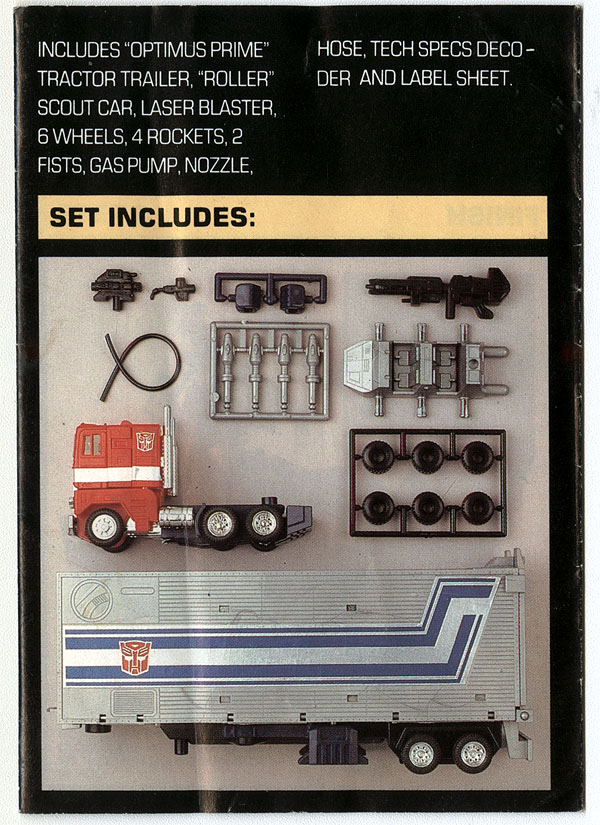
Well, no, not exactly. Look what we have here, another image from that same Transformers Optimus Prime instruction booklet, and this time the mock-up featured is no longer a unique hybrid release from that sticker-map photograph. It has a grey Roller, grey missiles, bloated parts, metal plates and now...dark blue trailer parts. So it seems to be one step further along the road than the hybrid Battle Convoy/Optimus shown in the sticker-map photograph and therefore one step ahead of the Ceji Joustra Diaclone stickermap source.
Clearly some sharing of source material between Hasbro/Takara and Ceji Joustra has occurred because both sets of sticker-maps are based on the same photo-shoot, and the Transformers Optimus Prime box artwork appears on the back of the Ceji Joustra Diaclone box, but it seems both went their separate ways and developed their products somewhat independantly after that initial common ground. Takara would have been supplying both companies, so it's not a great surprise that Joustra Diaclone and early pre-rub Transformers both got the metal plate/grey Roller/dark blue parts combination for their production release.
Does this lend any more weight to my proposed theory that Ceji Joustra asked the Brizzis to base their War On Diaclona story heavily on the Transformers mythos, thereby delaying the release of Ceji Joustra Diaclone toys in Europe even though they were featured in dealer catalogues at the very start of 1984? Inconclusive.
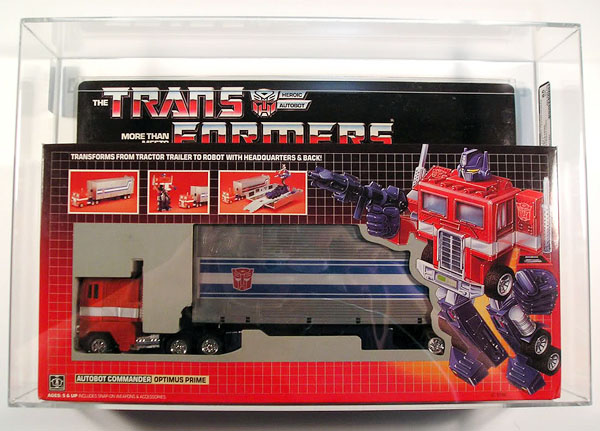
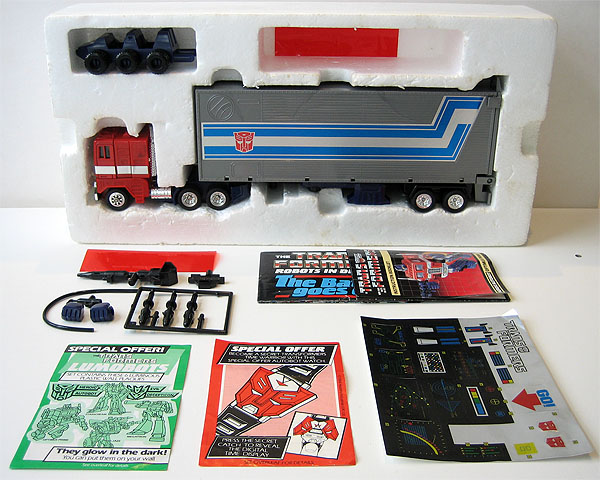
Moving on, we approach 1985 and the more standard rubsign-era Hasbro Transformers Optimus Prime toys where the box shows no errors, there are white borders around the stock images and the Optimus Prime toy has no metal plates, dark blue/purple trailer parts and Roller, black missiles and no bloated accessories. This is by far the most common version of Optimus Prime that appears for sale. The MISB specimen above is a US Optimus Prime, and the opened Prime is a UK release from the same period (different paperwork for a start).
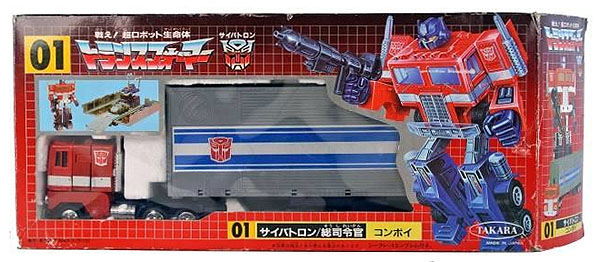
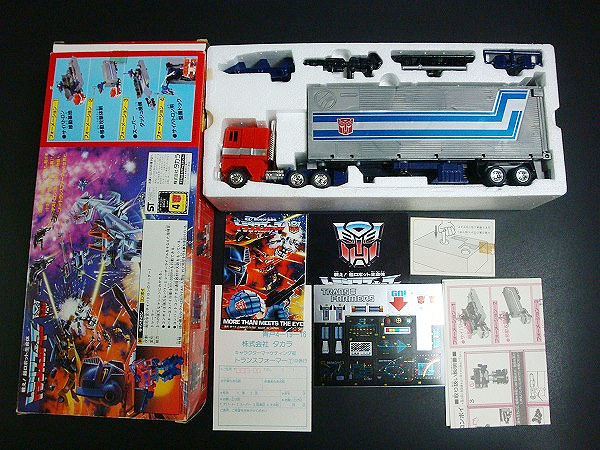
Next up it's the Takara-released Japanese Transformers 01 Convoy from 1985. The first photograph is a more standard rubsign-era mould from Takara, but the second photograph showing all the contents is a first release Japanese 01 Convoy with bloated parts, grey missiles and super-launcher like the Japanese Diaclone Battle Convoy! You can tell it has that launcher because Roller doesn't have the pegs at the rear. Notice that the styro is also very reminiscent of the Japanese Diaclone Battle Convoy, missing just the space for the Diaclone drivers above the red cab. The Takara 01 Convoy does not use Jeffrey Mangiat's US Transformers box artwork for Optimus Prime, the Japanese artwork was different and subsequently used for nearly all recent reissues.
Even though it's thought that those early 01 Convoys with the Battle Convoy-style moulding and Roller were corrected, that hybrid Convoy did appear again...
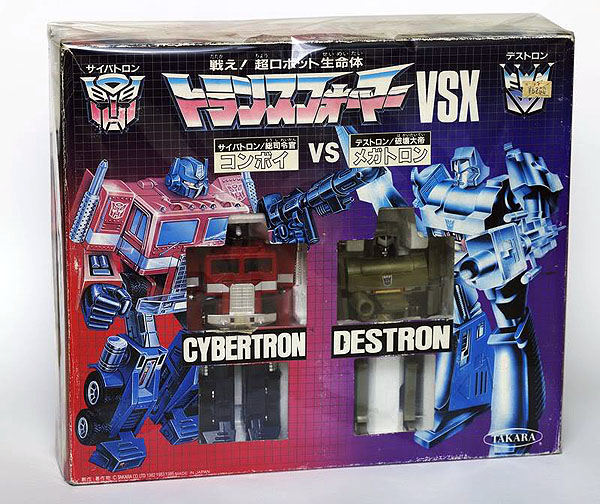
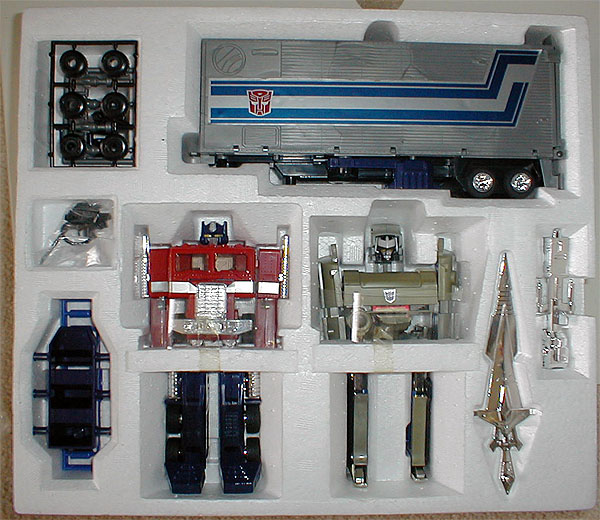
This immensely desireable and often mega-expensive Japanese exclusive VSX giftset of 01 Convoy and 16 Megatron also features the Japanese Diaclone Battle Convoy moulding on Roller (but darker blue), grey missiles and the mega launcher in the trailer. A fascinating series of events for sure. Even the cab for the VSX and early 01 Convoy appears to be Diaclone-mould with square smokestack connectors and the vertical red plastic bar next to it. I do wonder if the Convoy cab headplate has the ridges and tab or if it is identical to the Japanese Diaclone Battle Convoy cab.
Moving on again...
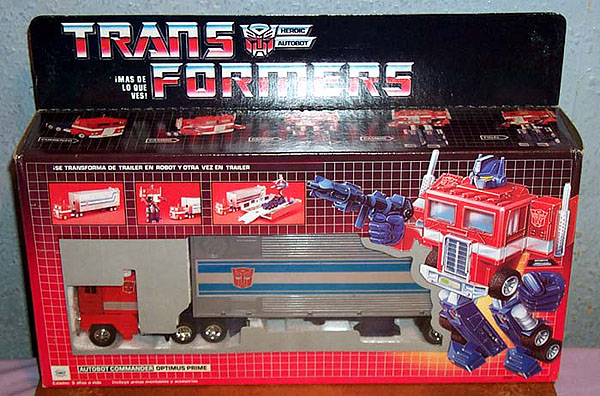
Just on a related note, the 1985 Mexican Transformers Optimus Prime manufactured by Plasticos Iga (as refererred to near the start) also shares the early pre-rub 'Error-box' characteristics: no white borders around the stock images, extra grid square near Prime's fist artwork - but the actual error involving the uncropped stock image of the command centre radar has been corrected. Notice the Mexican Prime has an Iga logo in the bottom left corner, Spanish text on the packaging, and missing silver stickers from the front of the cab. Those missing cab stickers are only evident on the late 1980s safety-tested Mexican Primes with the safety stickers on the boxes (and horrid repainted red eyes). First release Mexican Optimus Primes have full cab stickers and normal (lead-lined!) yellow eye paint.
The Portuguese Transformers Optimus Prime release has similarly laid out packaging, and is thought to be a much later Chinese manufactured product. You can see it here, lacking white borders and all:
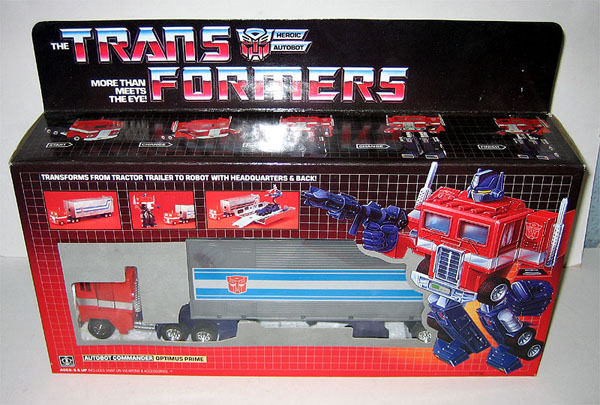
Staying in Europe, after Ceji Joustra Diaclone's huge success in mainland Europe throughout 1984, and the release of their now-rare Wave 2 toys in 1985, Ceji started to experience serious financial difficulty and an agreement was reached with Milton Bradley and Hasbro to purchase all of Ceji's remaining Diaclone stock and the exclusive licence to sell those Takara products in mainland Europe. Milton Bradley and Hasbro therefore became the exclusive holder of rights to release Optimus Prime in that region as a Transformer much later than their first wave of toys, hence why Jetfire was originally billed as leader of the Autobots in mainland Europe. But they couldn't very well just repackage the Diaclone Truck toys as they did with the Autobot cars, it still had "BATTLE CONVOY - DIACLONE" spread across its trailer!
It seems that the arrangement that Ceji and Hasbro Bradley came to involved Ceji manufacturing a large number of Optimus Prime toys in their own facilities on behalf of Hasbro Bradley, which is why you will see so many Optimus Primes in Europe sporting a "MADE IN FRANCE" copyright on the toy, and associated copyright text on the packaging as well. These toys are believed to have seen release in the UK as well as mainland Europe. In Europe in late 1985 they would have come packaged in Milton Bradley 'MB' boxes and later in 1986 in Hasbro Europe packaging.
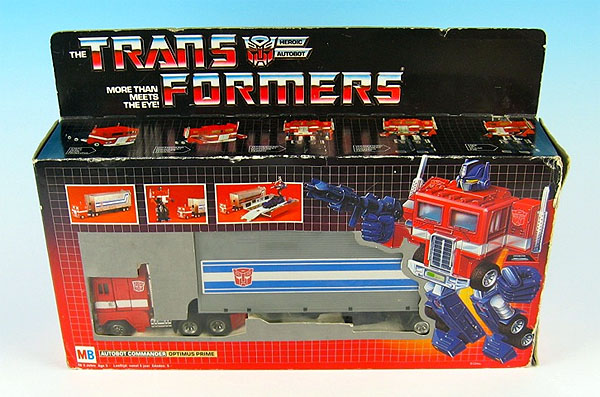
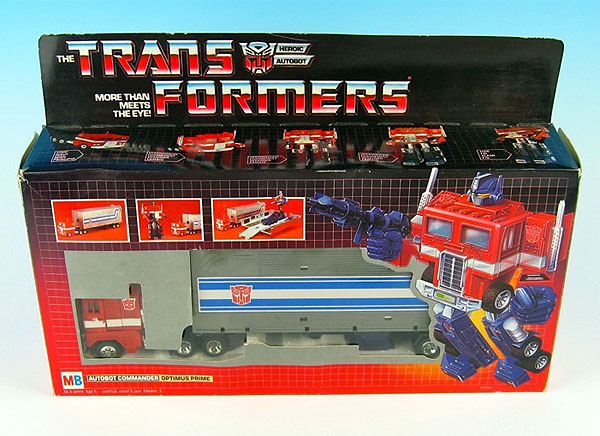
Notice the 'MB' logo in the bottom left corner of the box front. According to Mijo, the Milton Bradley Optimus Prime release comes with red feet and blue feet in roughly equal measure. There are red and blue-foot versions manufactured by Ceji (MADE IN FRANCE), and the red-foot version is pictured first above. The second photograph is of the Takara manufactured MB Optimus Prime...and it has metal plates on the trailer, and a grey Roller, grey missiles, bloated accessories (fists pictured below are from a different Prime), suitable copyright and same swirling in the grey plastic. It even has the Diaclone-mould cab with square smokestack connectors and vertical raised bar by the smokestacks.
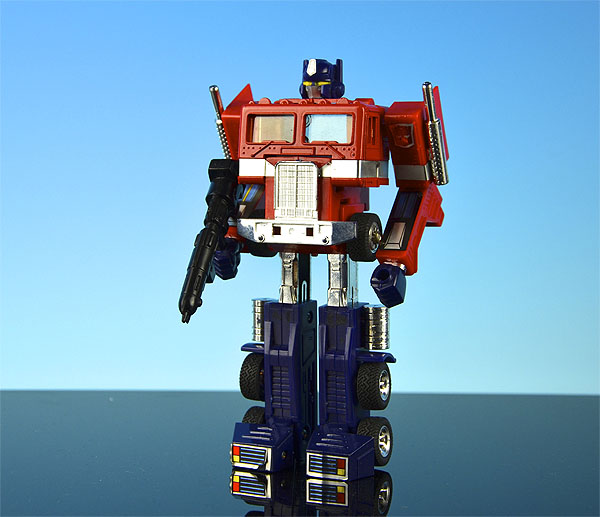
Could it be that some Ceji Joustra Diaclone Truck toys did indeed make it into Milton Bradley packaging and had their factory stickers altered to reflect their new Transformers status? With a rubsign added to the cab too? Why not? It happened to all the other Ceji Joustra Diaclone toys that Milton Bradley purchased and repackaged! That is after all how we ended up with a Red Transformers Tracks and Sunstreakers in MB Sideswipe packaging. How else could we explain a metal-plated Grey-Roller Prime being released in late 1985?
What makes this so confusing is that for their "Diaclone" range, Ceji were using Takara manufactured toys. However, when Hasbro Bradley got the rights, not only did some Takara manufactured toys end up in MB boxes, but Ceji were now manufacturing their own Optimus Primes in France, so they went from distributor and rights holder to manufacturer on behalf of Hasbro Bradley.

And here is another one of those Ceji-manufactured red-foot Optimus Primes, but not in Milton Bradley packaging, instead in UK packaging from 1986. You can tell it isn't Hasbro Europe packaging because it still has the "Transformers from..." text above the three stock photos on the box front. This 1986 red-foot Prime can also be found in Hasbro Europe packaging. To complicate matters further there are also 1986 blue-foot Optimus Primes in both UK and European Hasbro packaging. Who'd be an Optimus Prime completist?!
It does seem that the manufacture of these 1986 Optimus Primes (and other Transformers) on behalf of Hasbro Bradley counts as one of Ceji's last acts as a company before disappearing into history. Their financial predicament and the global rise of The Transformers signalled the end of the remarkable "Diaclone" toy range they unleashed upon mainland Europe, but what a legacy they left behind...
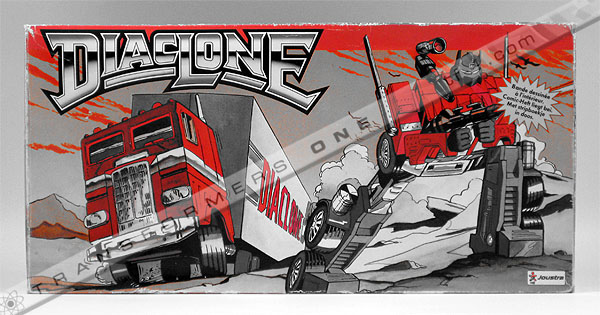
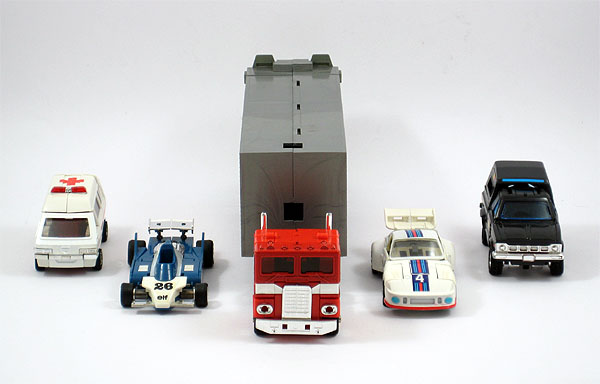
Whether it is the mesmerising box artwork that impresses you the most, that wondrous mural dedicated to the Diaclone Battle Convoy that became one of the world's most famous and widely-sold toys in its subsequent incarnation, or whether it is the importance of being the only version of that hallowed original toy to have seen release outside of Japan, it would be impossible to find a collector who would not appreciate and connect with the Ceji Joustra Diaclone Truck on some level. Even if that level is just a case of having the chance to own a vintage Battle Convoy of some description, it is possible for many collectors because this probably sold exceptionally well back in its day.
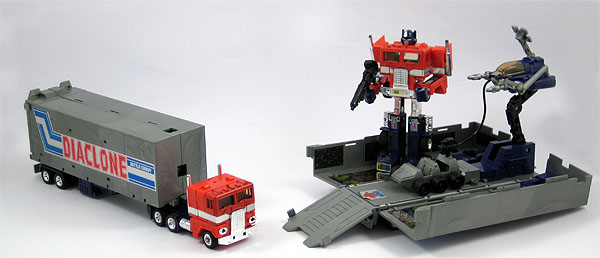
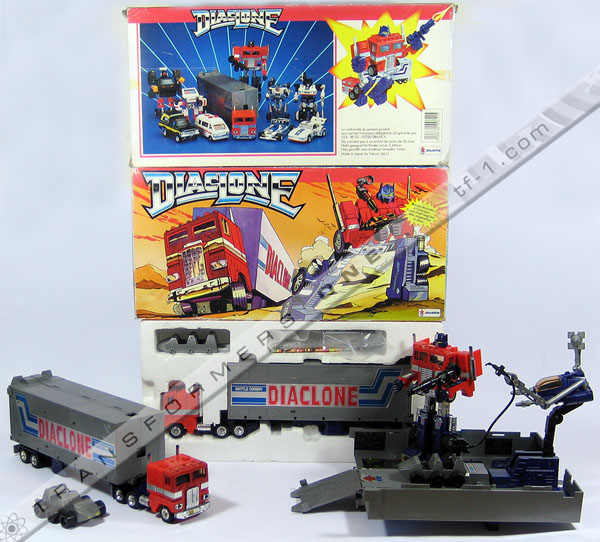
Loose Ceji Joustra Diaclone Trucks can be found on auction and on websites relatively frequently, often damaged, and almost never perfect or complete. I am yet to see a completely perfect example of a MIB Ceji Joustra Diaclone Truck featuring a totally undamaged box, completely unused toy and parts with unused stickersheet and the mini-comic included. There's always one thing missing, and of those examples of near-perfect Diaclone Trucks belonging to well-known vintage Optimus Prime & Convoy collectors, even Elvin Pena's old unused one lacked a stickersheet, and Ultraconvoy's current unused specimen lacks the comic. My own example may have an unused toy and partly unused but complete accessories and comic, but I don't have the stickersheet. Respect must be given where it is due, and this piece deserves it.
For me personally the Diaclone Truck represents the poster-boy, the talisman, the epitome of what makes Ceji Joustra Diaclone appealing and great. A unique toy with unique presentation and a unique significance in the history of the greatest toy line the world has ever seen. Truly one of a kind.
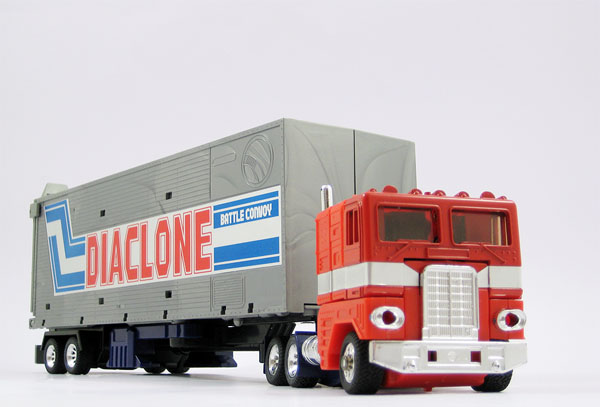
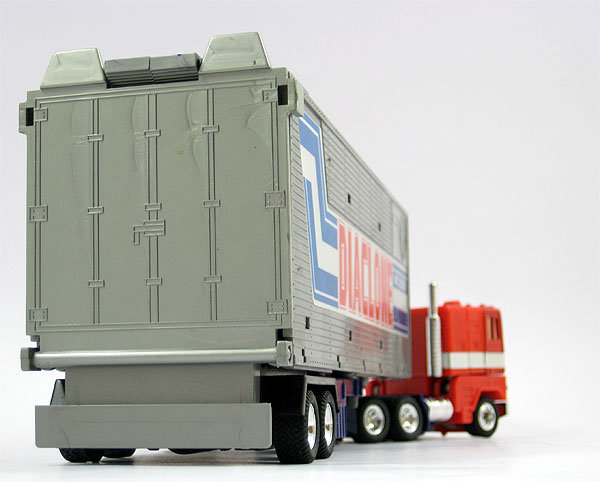
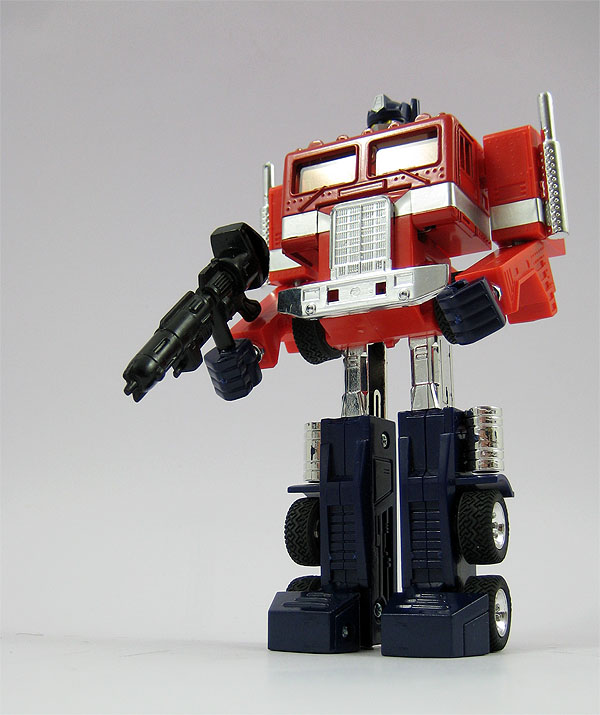
My endless thanks go to Mijo for MB Prime images. Further (and quite essential) reading on the Milton Bradley 'MB' Optimus Prime variants can be done here at 20th Century Toy Collector, courtesy of Mijo.
I'd also like to thank Ultraconvoy for Diaclone Truck stickersheet images, Alessandro Musconi for unused Japanese Battle Convoy images, Ras for VSX images, HighPrime for Grey Roller Prime image, Jon Krause for AFA Optimus Prime image, Giacomo Cellesi for Chapter 10 scans, Yahoo Japan seller ciuyi77 and TFsource for 01 Convoy images and 1500BC.com for the prototype Battle Convoy scan.
All the best
Maz@tf-1.com















